LG B5 is really a good OLED television, which shows that you don't have to spend a fortune for very good quality. It offers deep blacks typical of organic panels, very good colour reproduction – especially after calibration – and enjoyable HDR movie watching experiences. All of this means that evening screenings can provide cinema-like emotions even without resorting to much more expensive screens. The smoothness of the picture and the set of features for gamers also deserve recognition. A 120 Hz panel, low input lag, full support for HDMI 2.1, variable refresh rates, and Dolby Vision Gaming mode make the B5 a very versatile screen – both for gaming and watching sports. The friendly webOS system with a Magic remote adds to the package, providing convenient access to content and simplifying operation. However, not everything is perfect. Compared to the B4 model, a slight drop in brightness can be noticeable, especially in very bright rooms. For some users, the lack of DTS audio support may also be a problem, which could force some workarounds when connecting Blu-ray players. Despite this, LG B5 remains one of the most sensible choices for those who want to enter the world of true cinema – without overspending, but also without major compromises. It's a screen that doesn’t need to prove anything – it simply delights the eye with excellent picture quality and works as it should.
- Matching (Score)
- Our verdict
- TV appearance
- Where to buy
- Contrast and black detail
- HDR effect quality
- Factory color reproduction
- Color reproduction after calibration
- Smoothness of tonal transitions
- Image scaling and smoothness of tonal transitions
- Blur and motion smoothness
- Console compatibility and gaming features
- Input lag
- Compatibility with PC
- Viewing angles
- TV efficiency during daytime
- Details about the matrix
- TV features
- Apps
- Playing files from USB
- Sound
LG OLED B5 vs Samsung The Frame 2025 (LS03F)
Direct compare
The Frame / LS03FAU
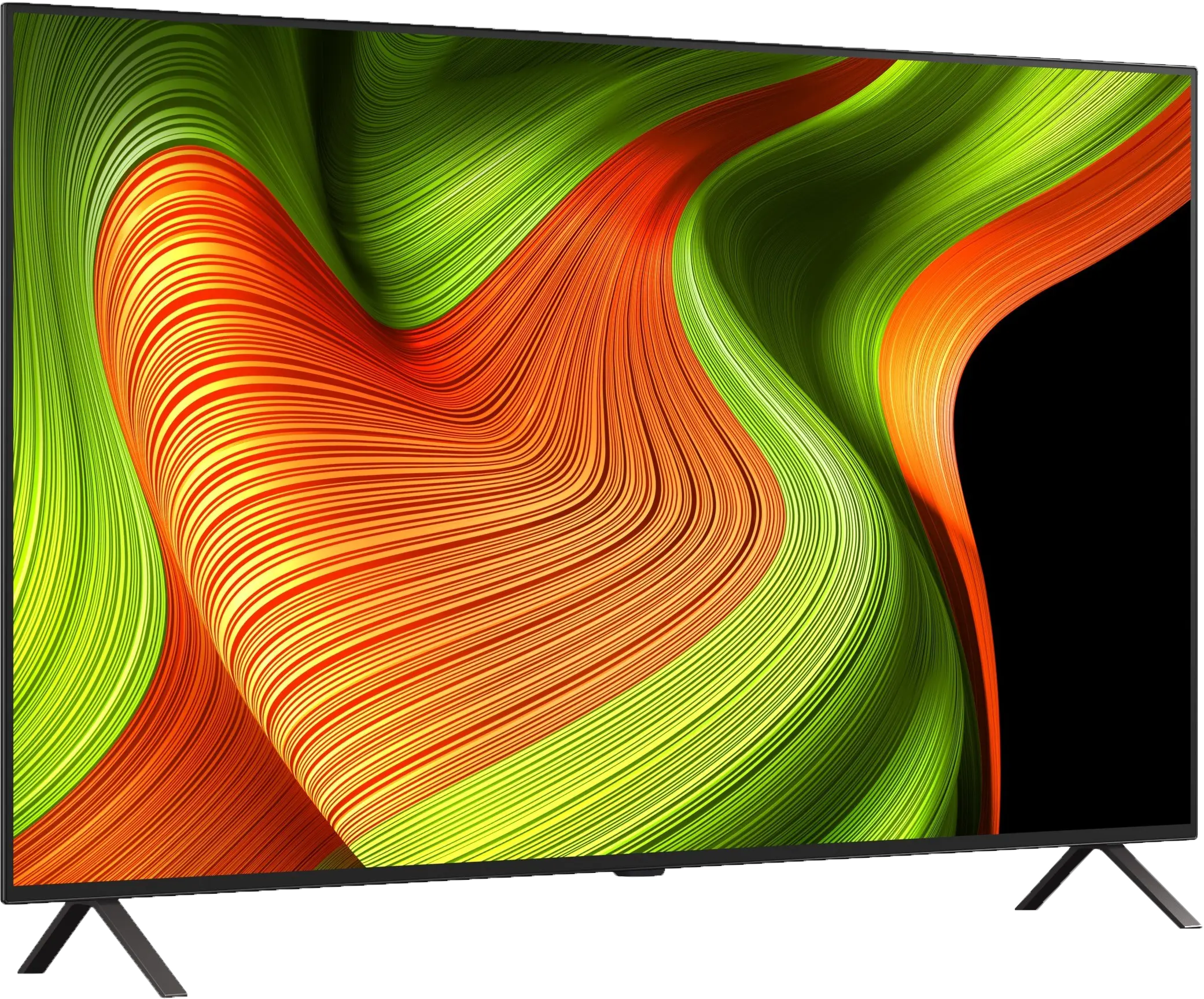

Panel type: WRGB OLED
Resolution: 3840x2160
System: WebOS
Model year: 2025
Complete the survey to find out the result

Panel type: LCD VA
Resolution: 3840x2160
System: Tizen
Model year: 2025
Complete the survey to find out the result

Overall rating
7.8
7.0
Movies and series in UHD quality
7.9
6.8
Classic TV, YouTube
8.6
6.5
Sports broadcasts (TV and apps)
8.5
6.4
Gaming on console
9.2
8.3
TV as a computer monitor
7.6
8.2
Watching in bright light
4.9
6.3
Utility functions
8.3
8.1
Apps
8.7
8.7
Sound quality
7.0
6.0
Complete the survey to find out what fits your preferences
Advantages
Perfect black and contrast
Pleasant image in HDR format
Excellent colour reproduction capabilities
120Hz OLED panel - great motion fluidity
4 HDMI 2.1 ports and full support for gamers (VRR, ALLM, Dolby Vision Gaming, HGiG)
Very low input lag
Correct content scaling and good digital processing
User-friendly webOS system with a Magic remote
Built-in USB recording function from built-in DVB-T/T2 tuners
Matte display excellently reduces reflections
Customisation options for the screen thanks to interchangeable frames + art mode
Free accessories in the form of a wall mount + OneConnect module
High native contrast
Decent brightness
High refresh rate - 120/144Hz
Many features for gamers - VRR, ALLM, Gamebar, proprietary motion smoother working in games
Disadvantages
Average brightness and poor performance in bright rooms
No support for DTS formats
Different remote versions in derivative models – difficult to predict which version we will receive
Missing HGiG mode – makes precise HDR adjustments on the console difficult.
No DTS support – requires additional hardware for some films on Blu-ray discs.
Paid picture mode
Our verdict
Samsung The Frame 2025 is a television unlike any other – and although competition has emerged for it, it still does it best. The matte panel, flush mounting with the wall, and a single thin cable thanks to the One Connect module make the device resemble a picture more than any other screen. The Art Store app continues to offer the best scans of artworks on the market (even if they are subscription-based), and with interchangeable frames, we can adapt the TV to the interior almost like a piece of furniture. As for the picture itself, since we are also talking about an ordinary television, there are no major changes, but there are also no disappointments compared to last year’s model LS03D. The Frame still offers high native contrast and solid brightness at 600 nits, which combined with the matte finish provides very comfortable daytime use. The colours are not as vibrant as in glossy screens, but against the backdrop of competitive matte constructions, they perform the best. A novelty is the 144 Hz refresh rate, although in practice, mainly PC gamers will benefit from it. Indeed, in terms of gaming features, The Frame has nearly everything: low input lag, variable refresh rate (VRR) support, automatic game mode (ALLM), Game Bar, and a unique motion smoother designed for games. Unfortunately, not everything is as perfect as it might seem. Why? Because the HGiG mode is missing, which has suddenly disappeared from the latest version of the Tizen system. Samsung really should respond to this, as for many gamers it is a key element in choosing a screen. And we fully understand that. Even though LS03F The Frame 2025 does not bring greater revolutions, it is still a unique television that, apart from its appearance, offers quite solid picture quality and extensive gaming features. It’s a pity that year after year we also receive new compromises.
TV appearance
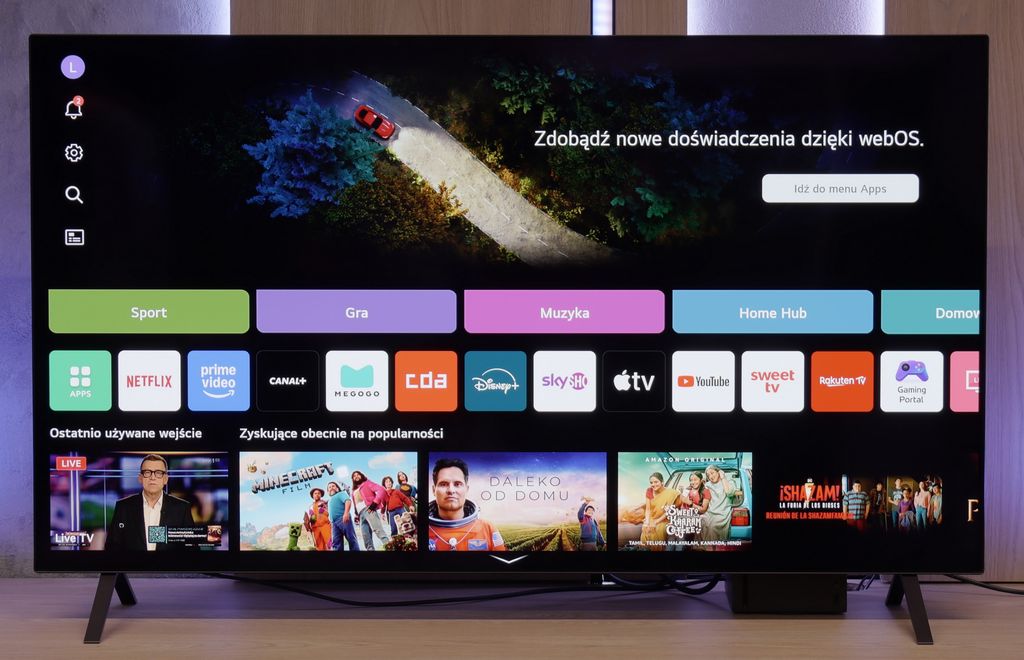
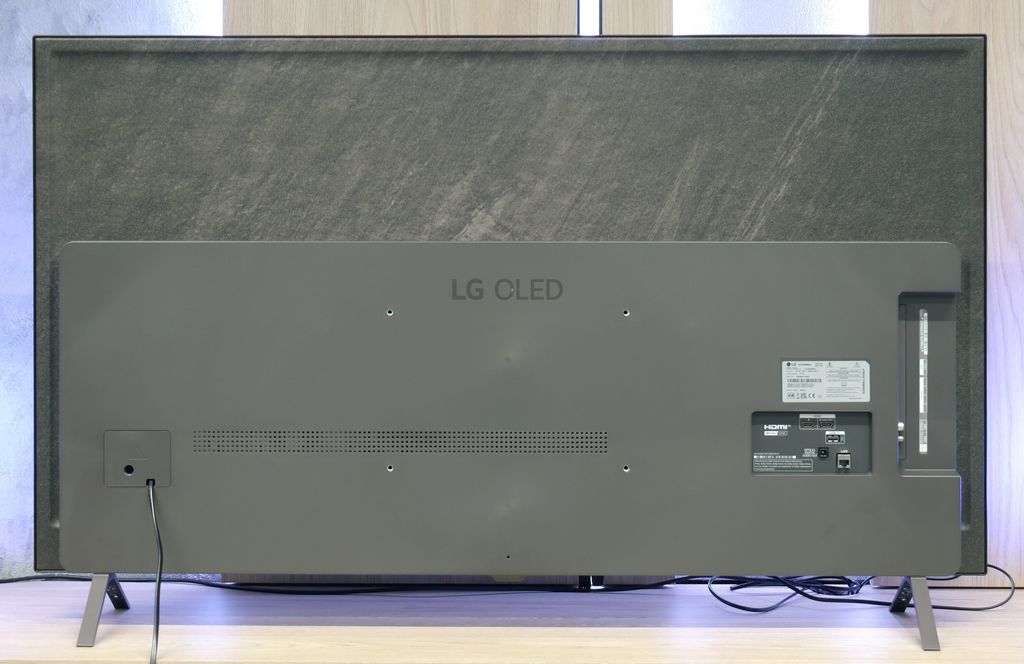

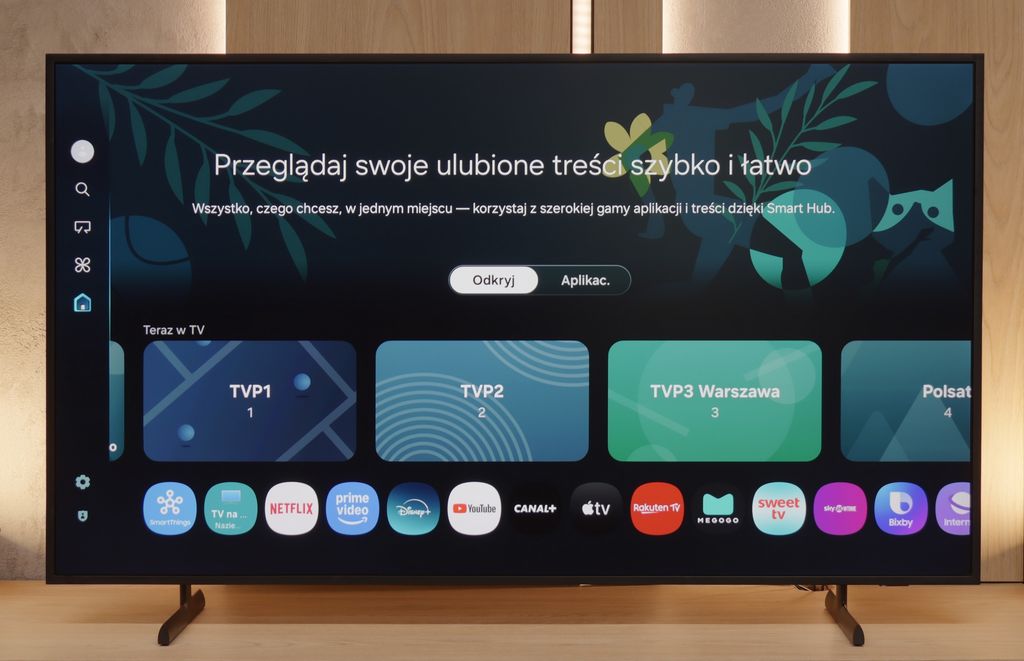
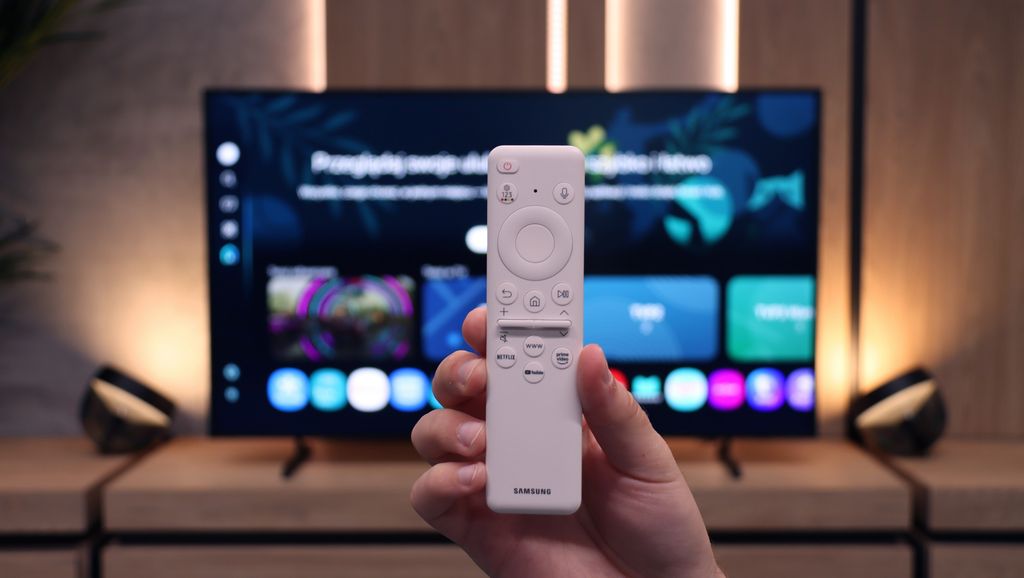

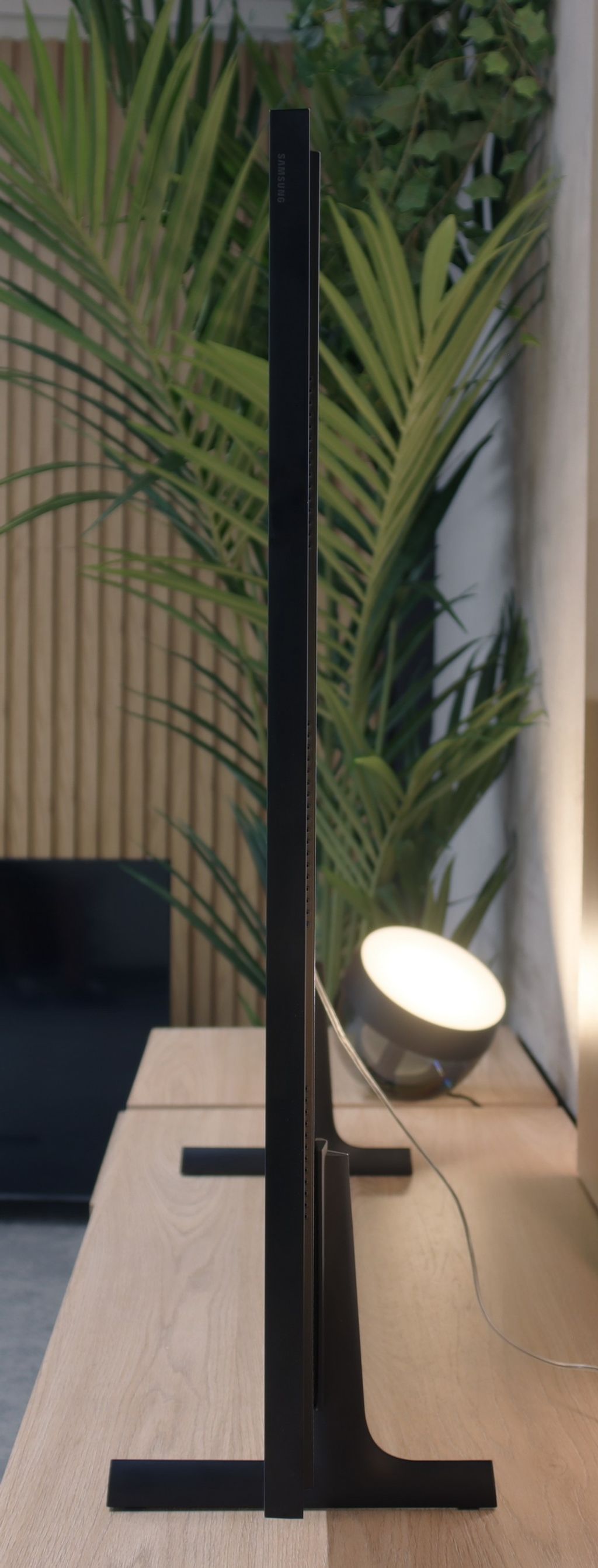
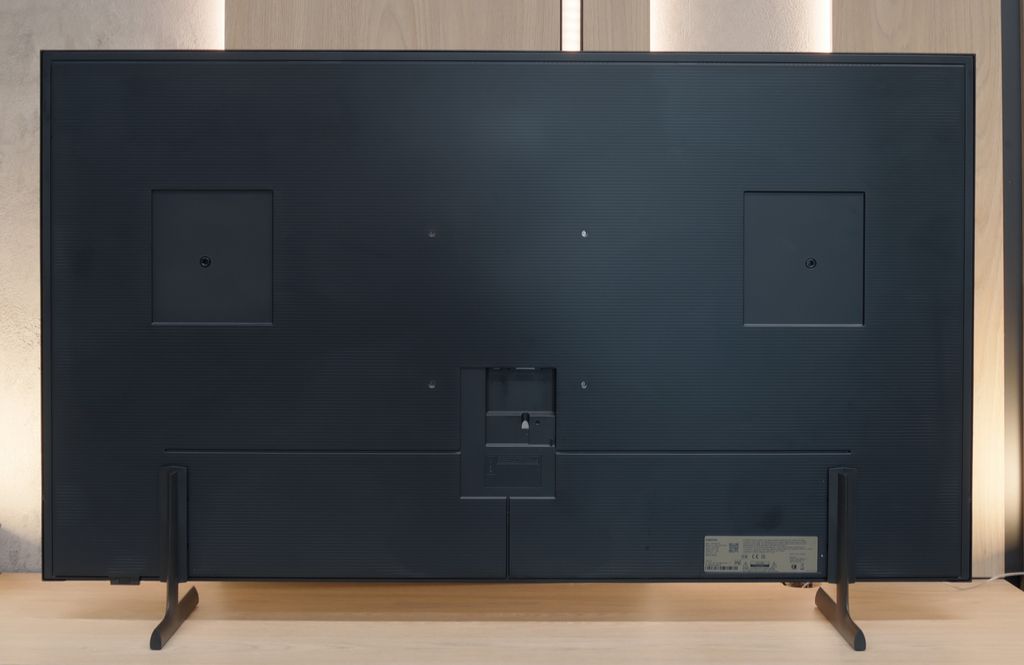
Contrast and black detail
10/10
6/10
Local dimming function: No
Contrast:

Result
∞:1

Result
∞:1

Result
∞:1

Result
∞:1

Result
∞:1

Result
4,800:1

Result
4,750:1

Result
14,900:1

Result
4,500:1

Result
4,300:1
Halo effect and black detail visibility:

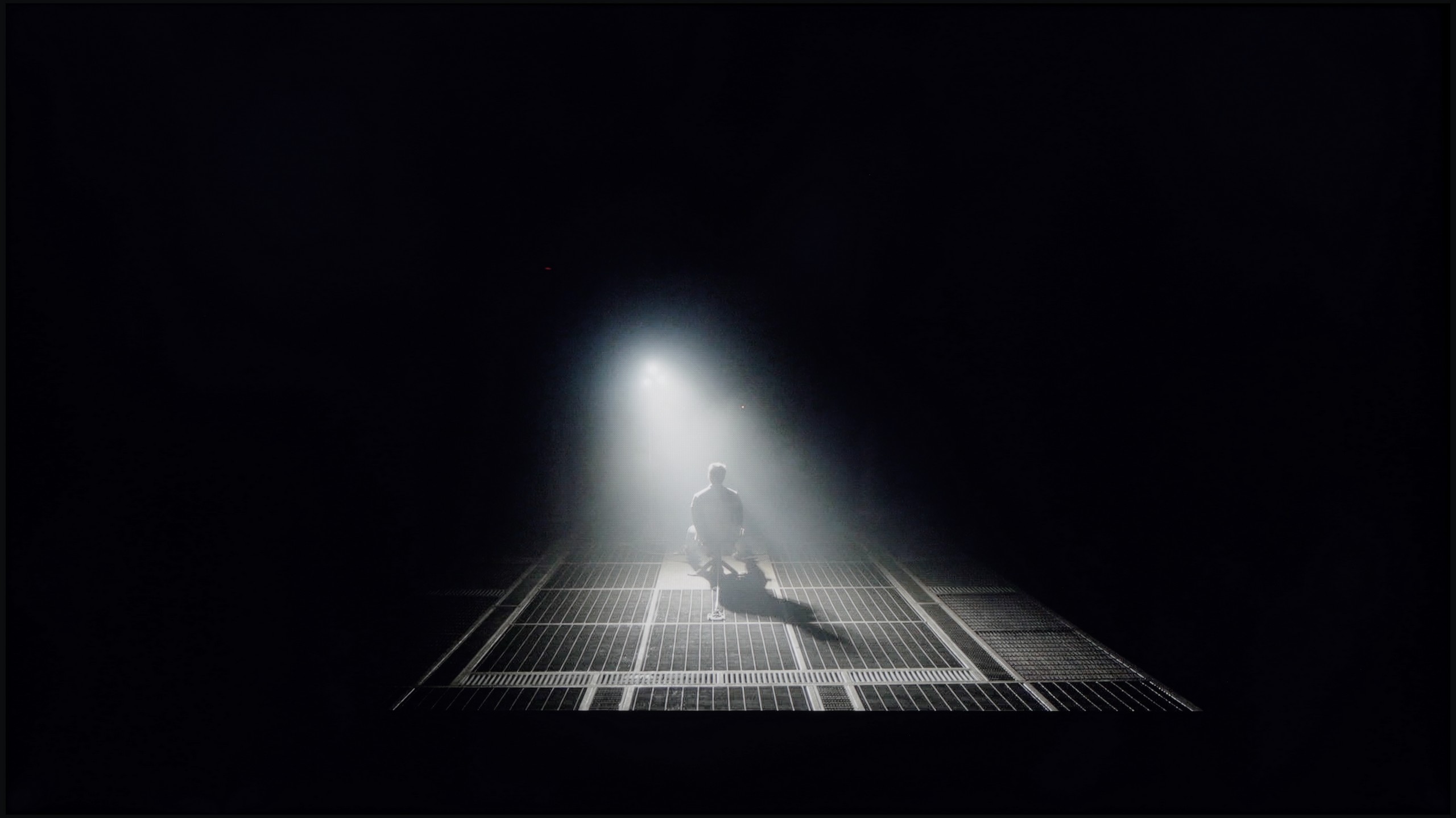
If you are looking for changes compared to last year's LG B4, we will immediately dispel any doubts – you won't find any in this category at all. And that's good. Because how to improve something that is already bordering on perfection? The LG B5, as a television with an organic WOLED panel, offers black as tar scenes and a contrast that is hard to find even in the most expensive LCD screens. The display is as clear as a bell – no bleed-through, no streaks, no halo effects that can ruin the atmosphere in cinema scenes. Here, everything is in its place. Details separate from the black with surgical precision, nothing blends together, even in the most demanding sequences from films such as The Revenant or Oblivion. This is the type of television that can enchant you, especially when the room goes completely dark. When the lights go out, the LG B5 takes centre stage – and it does so spectacularly. In these conditions, OLED shines the brightest, and even top LCD models – despite advanced dimming and hundreds of zones – simply fall behind.
The year 2025 promises to be quite interesting when it comes to lifestyle televisions. Why? Because Samsung has prepared two versions of the iconic model The Frame – one standard and the other with the addition of “Pro”. In this review, we take a look at the version without “Pro”, which – as we shall see shortly – is quite significant. The standard model LS03F lacks any local dimming technology, unlike its more expensive sibling. This is important because it affects not only the overall picture quality but, primarily, how this television handles black levels.
The VA panel used in The Frame 2025 has a high native contrast – and this obviously works to its advantage. In the tested film scenes, details in the dark areas of the image were well visible, nothing blended together, and there was no formation of a uniform black/white blob. For the average viewer, this will be more than sufficient. But of course, not everything is perfect. The absence of local dimming means that the black levels on this television are not perfectly deep – they resemble dark navy rather than tar. Additionally, in our tested unit, we noticed slight blooming in the right part of the screen, but this could simply be the “quirk of the specimen” rather than a rule. Theoretically, one could try to improve the perception of black by backlighting the screen – for example, with an LED strip – but in the case of The Frame, this is rather impossible, as this television is meant to sit flush against the wall like a picture. So to achieve a better black visible to our eyes, we are forced to watch the LS03F with the lights on. That’s the charm of this technology.
HDR effect quality
6.2/10
6/10
Luminance measurements in HDR:

Result
587 nit

Result
593 nit

Result
628 nit

Result
589 nit

Result
470 nit

Result
642 nit

Result
589 nit

Result
574 nit

Result
584 nit

Result
631 nit
Scene from the movie “Pan” (about 2800 nits)


Scene from the movie “Billy Lynn” (about 1100 nits)


Static HDR10


Dynamic: Dolby Vision
Dynamic: HDR10+


HDR luminance chart:
Samsung The Frame 2025 (LS03F)
Luminancja HDR
Luminance of RGB colors
LG OLED B5
Luminancja HDR
Luminance of RGB colors
The LG B5 is a moderately bright OLED television. Regardless of the scene, it can generate around 500 nits of peak brightness. Interestingly, it achieves this even in full-screen shots saturated with white, where most OLEDs typically struggle. So is this screen suitable for HDR films? Indeed – and very much so, because such brightness allows you to truly feel the magic of HDR effects. However, it is worth noting that compared to last year's B4 model, the new B5 is darker – by about 100 nits. It may seem like a small amount, but at such average peak values, it makes quite a significant difference. Fortunately, the television compensates with another advantage – excellent coverage of the DCI-P3 and BT.2020 colour gamut. As a result, HDR films look really colourful, vibrant, and impress even in more demanding scenes.
The Frame LS03F is a television that can surprise with its brightness. The maximum luminance reaches around 650 nits, which already looks impressive on paper. But as we know, laboratory tests are one thing, and real film scenes are quite another. When watching HDR materials in natural conditions, The Frame 2025 maintains very good results. In most film scenes, the peak brightness remained at around 550–650 nits. This is a sufficient value to feel the difference between standard picture quality and that of HDR – bright highlights, reflections on water, or moonlight are presented clearly and spectacularly.
It is also worth remembering that the LS03F is a QLED television, which translates into solid colour saturation. The coverage of the DCI-P3 colour space reaches about 92%, allowing for vibrant, intense colours in HDR content. This is not the level of top premium models, but for a lifestyle screen, the result truly deserves recognition.
Factory color reproduction
8.2/10
7.1/10


Factory Mode
After calibration

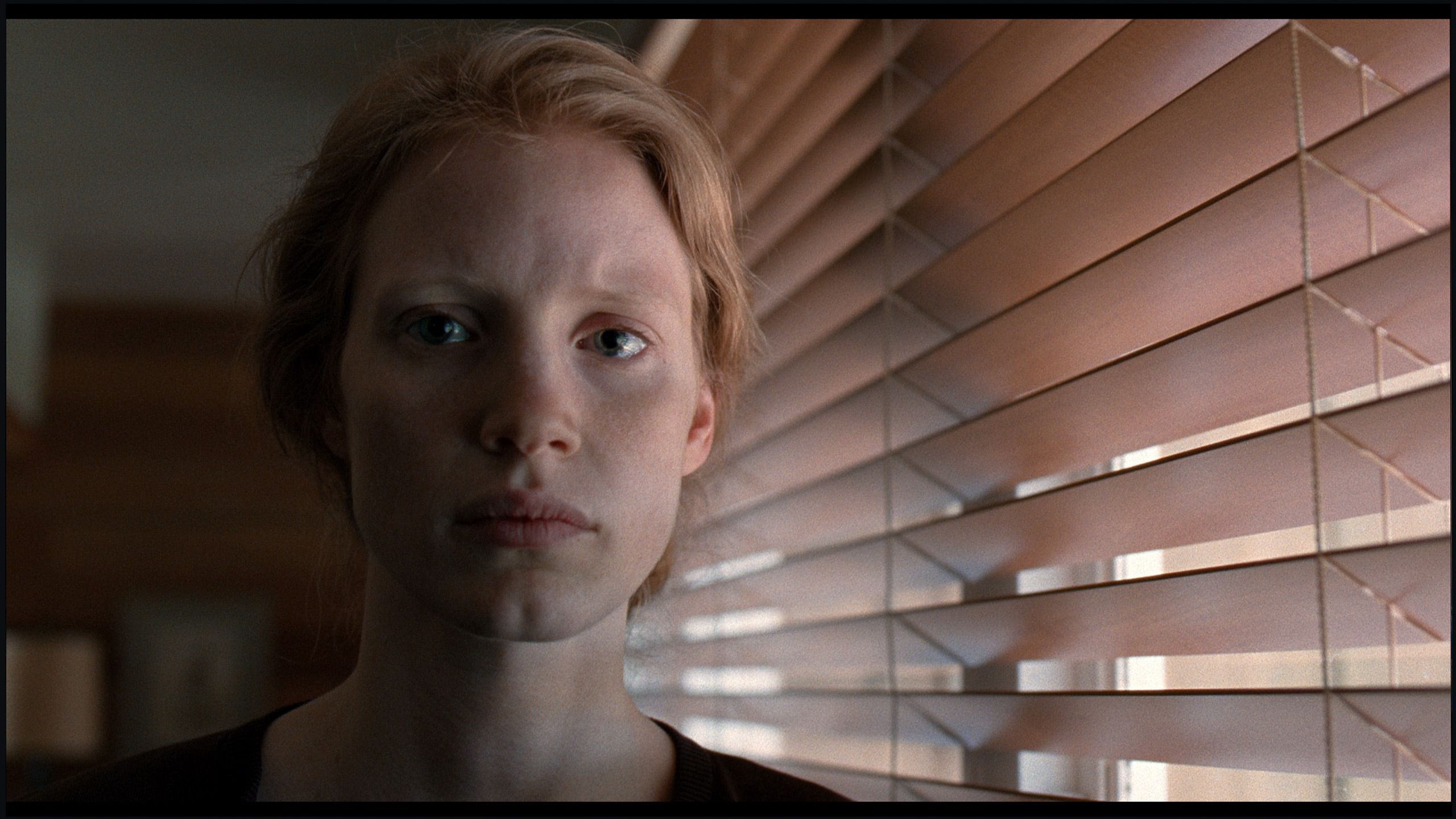
Factory Mode
After calibration
We tested the B5 in Filmmaker mode and... we would love to see more TVs like this straight out of the box. Truly. The white balance is set very well – there's practically nothing to complain about. Well, if one were to nitpick, one might notice a slight deficiency in blue, which makes the overall image seem slightly yellowish. But that’s just our editorial quibbling. Most of you probably wouldn’t even notice it. We also have minimal reservations about brightness management in HDR format. The EOTF curve – which is responsible for how the TV distributes brightness in a scene – is slightly below ideal. In practice, it may happen that the darkest parts of the image are displayed too dark and simply… disappear. But these are details that only come out in measurements. Generally: we are impressed. However, we also know that LG TVs respond very well to professional calibration. You can achieve almost reference-quality picture from them, so – while it's already very good out of the box – we allowed ourselves to go a step further and refine everything to perfection.
When it comes to image quality straight out of the box, even in Filmmaker mode, which is supposed to be the closest to reference, there were issues. We noticed clear deviations in white balance in both HD and 4K HDR content. The image was heavily skewed towards red and blue, giving the screen a characteristic pinkish tint. This effect was most noticeable in bright scenes – for example, in shots with a lot of white, where neutral light should naturally dominate. At such moments, the screen clearly took on pink tones, which is also visible in the attached comparison photo. As for the brightness characteristics – it wasn’t as bad as one might expect with such colour inaccuracies. The analysis of the gamma curve and EOTF showed a slight brightening of the image compared to the reference, but not enough to drastically ruin the viewing experience.
Color reproduction after calibration
9.1/10
8/10


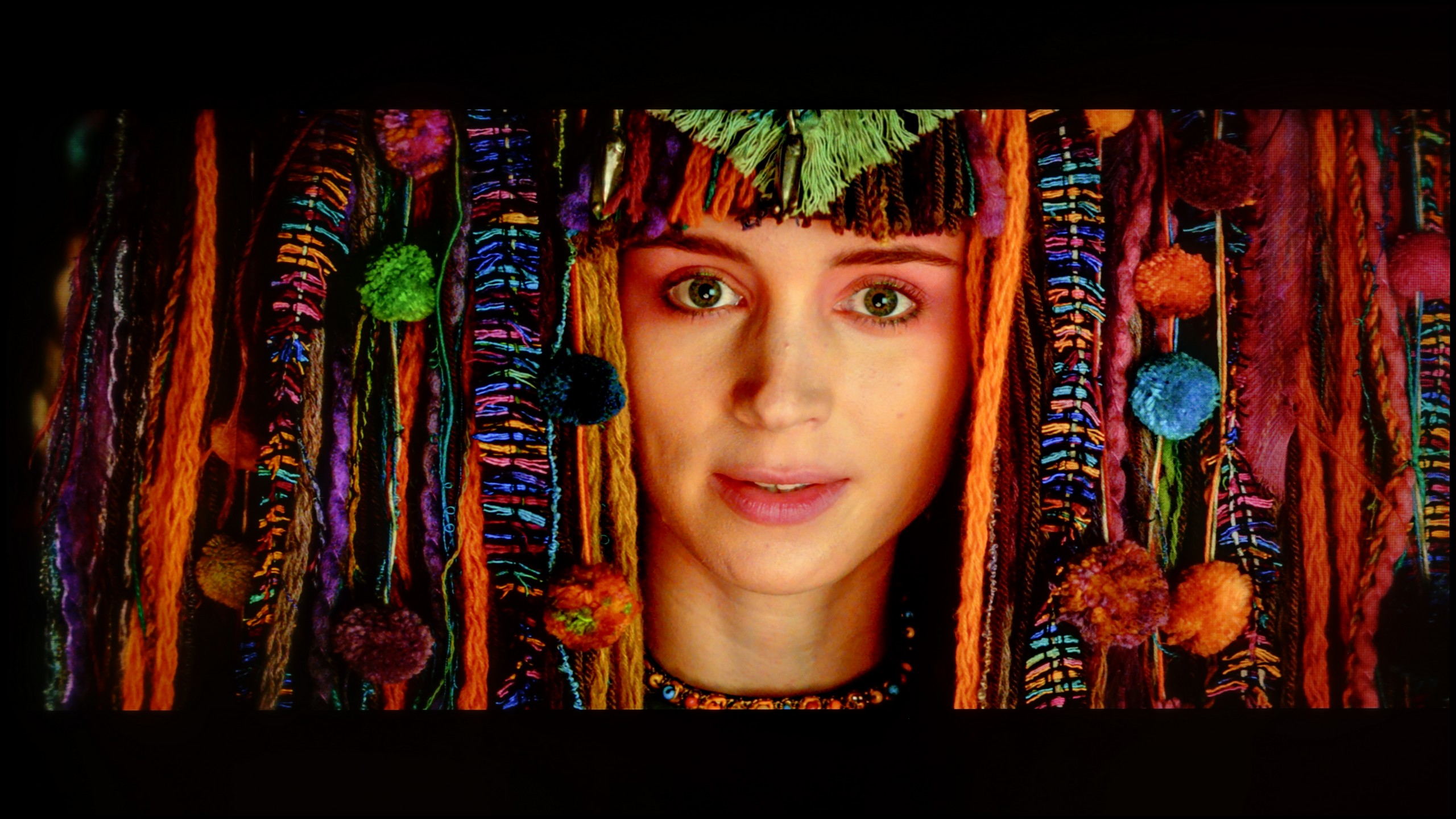

We must admit that we didn't have much work with the LG B5. It's one of those televisions that look good right from the start, but after calibration… they can really impress. The white balance was brought to almost perfect levels – to the point of errors that are invisible to the human eye, unless you are a professional colourist with a magnifying glass at the screen. We also managed to master the tendency of the television to slightly dim the darkest details, particularly in HDR scenes. After proper tuning, everything looks cohesive: black remains deep but does not consume information. Highlights maintain their natural sparkle, and colours align with the director's vision. This is truly one of those models that shows you don't have to spend a fortune to have an almost reference-quality picture. If you can opt for professional calibration – it’s definitely worth it in the case of the B5.
After calibration, the movie mode has gained a completely new quality. The issue of the pink tint, which had been clearly visible before, especially in bright scenes, has been effectively eliminated. Colours now look much more natural, and the white balance no longer dominates the rest of the image. It is no longer the same exaggerated "box picture" – everything now has coherence and a cinematic character. Additionally, the tendency of the television to slightly brighten scenes, previously visible in the EOTF curve analysis, has been partially corrected. Of course, this is within the limits of what the design allows without local dimming – one cannot speak of perfect brightness management here. Nevertheless, the final effect was definitely closer to what one might expect from a mode called Filmmaker.
Smoothness of tonal transitions
7.2/10
9/10

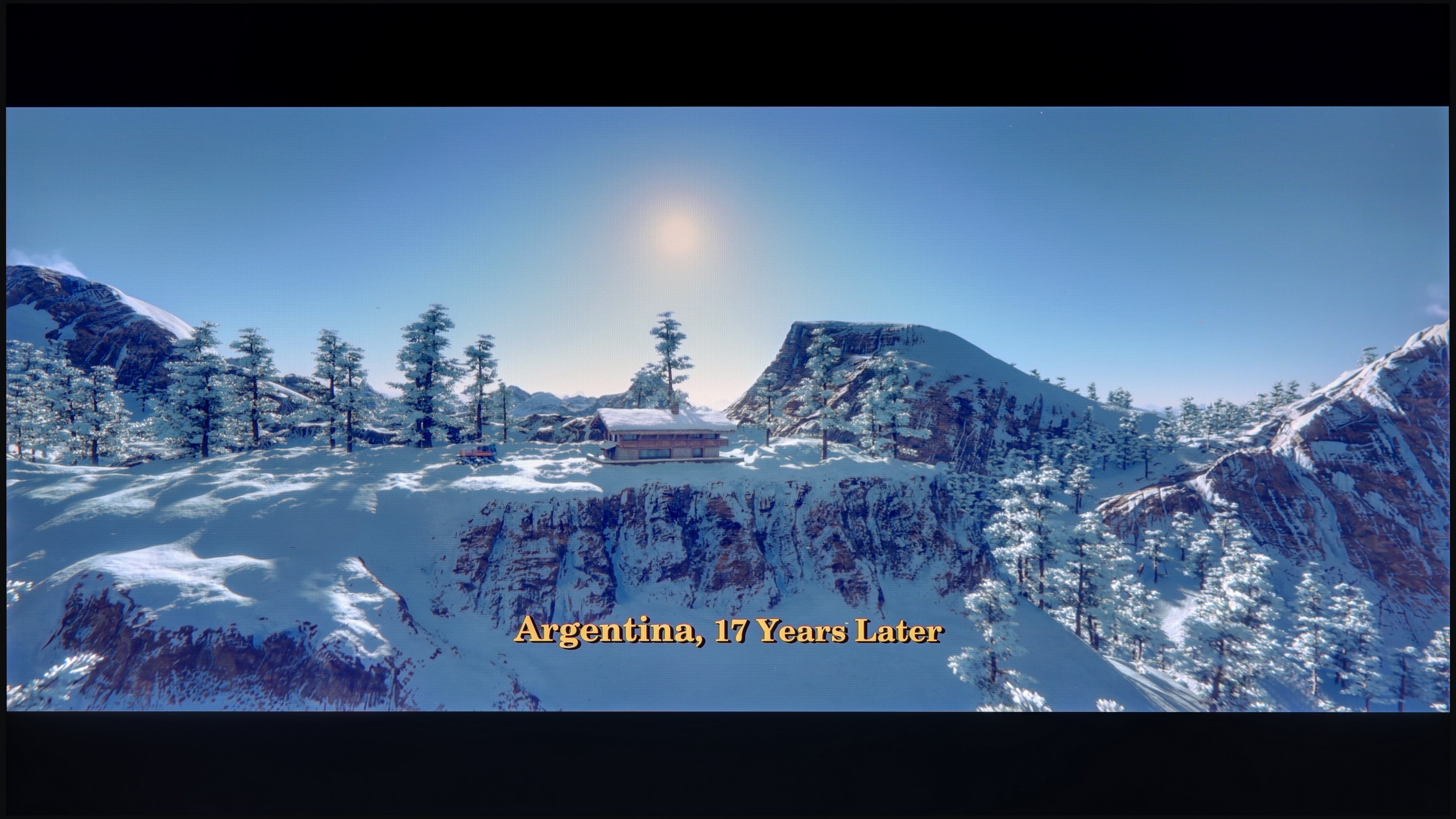








The LG B5 handles colour gradation quite decently. In bright scenes, where we have smooth transitions between skin tones, the sky, or backgrounds, the television blends colours seamlessly and without any jarring effects. At first glance – it looks good, especially considering the price. However, it is enough to reach for more challenging material – those darker, more demanding scenes with a lot of subtle transitions – and the challenges begin. Minor artefacts, false contours, and slight thickening appear. It is still not a level that dazzles or distracts from the narrative, but the difference compared to more expensive WOLED models – and even more so QD-OLED screens – becomes noticeable.
In terms of the smoothness of tonal transitions, the LS03F maintains a high standard – just like last year’s models. The television did not encounter any issues when testing more challenging film scenes, where noticeable transitions between shades of colour can easily occur. The colour gradation is very good here – both in the lighter and darker areas of the image. We did not observe the typical banding effect or other disturbances that could be distracting while watching films. If we were to nitpick, in the most demanding scenes – with subtle transitions and delicate gradients – minor imperfections can be detected. But only if one approaches the screen very closely and begins to analyse the image from a distance not intended by the manufacturer.
Image scaling and smoothness of tonal transitions
7.5/10
6.7/10
Smooth transition function
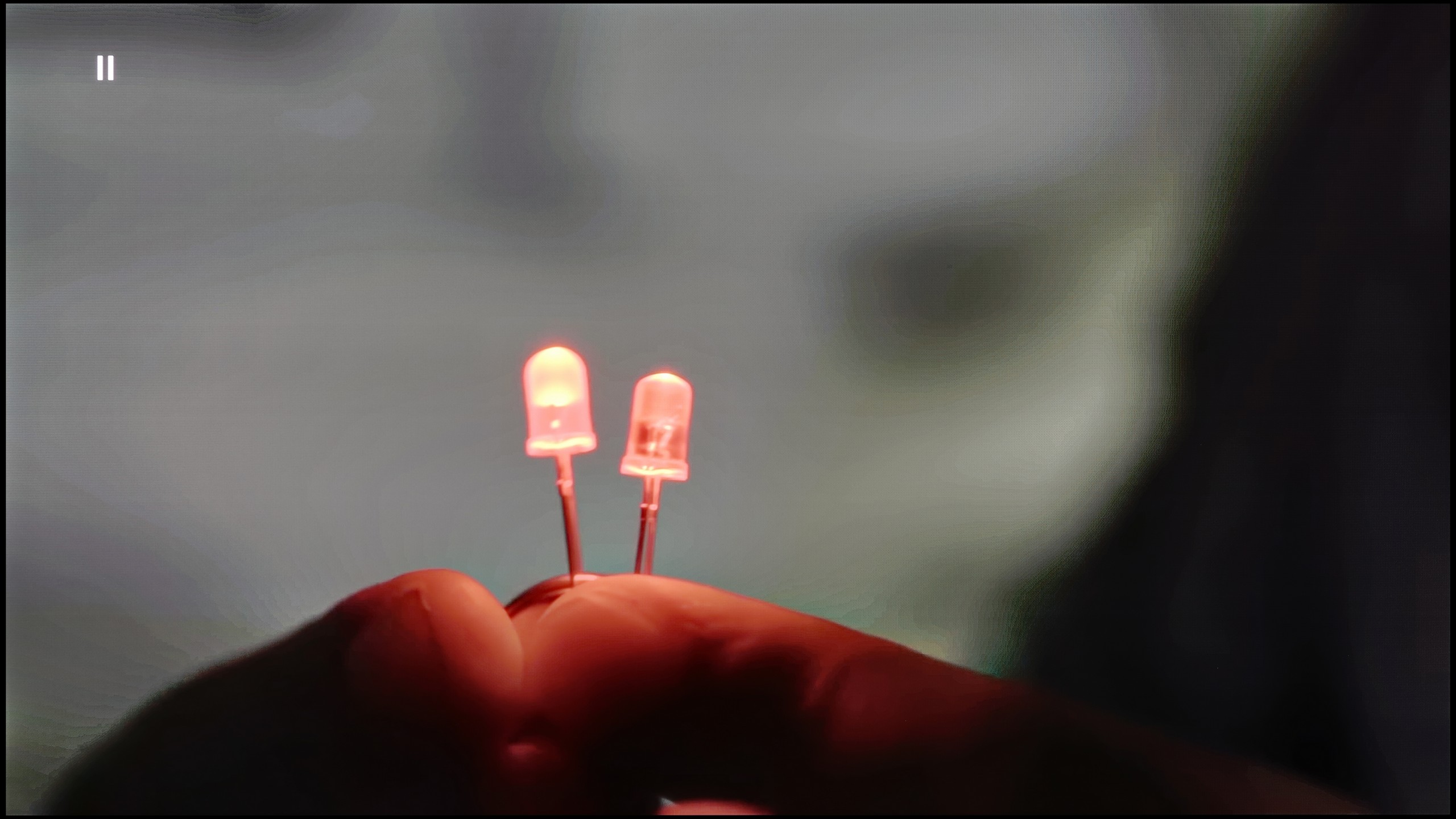
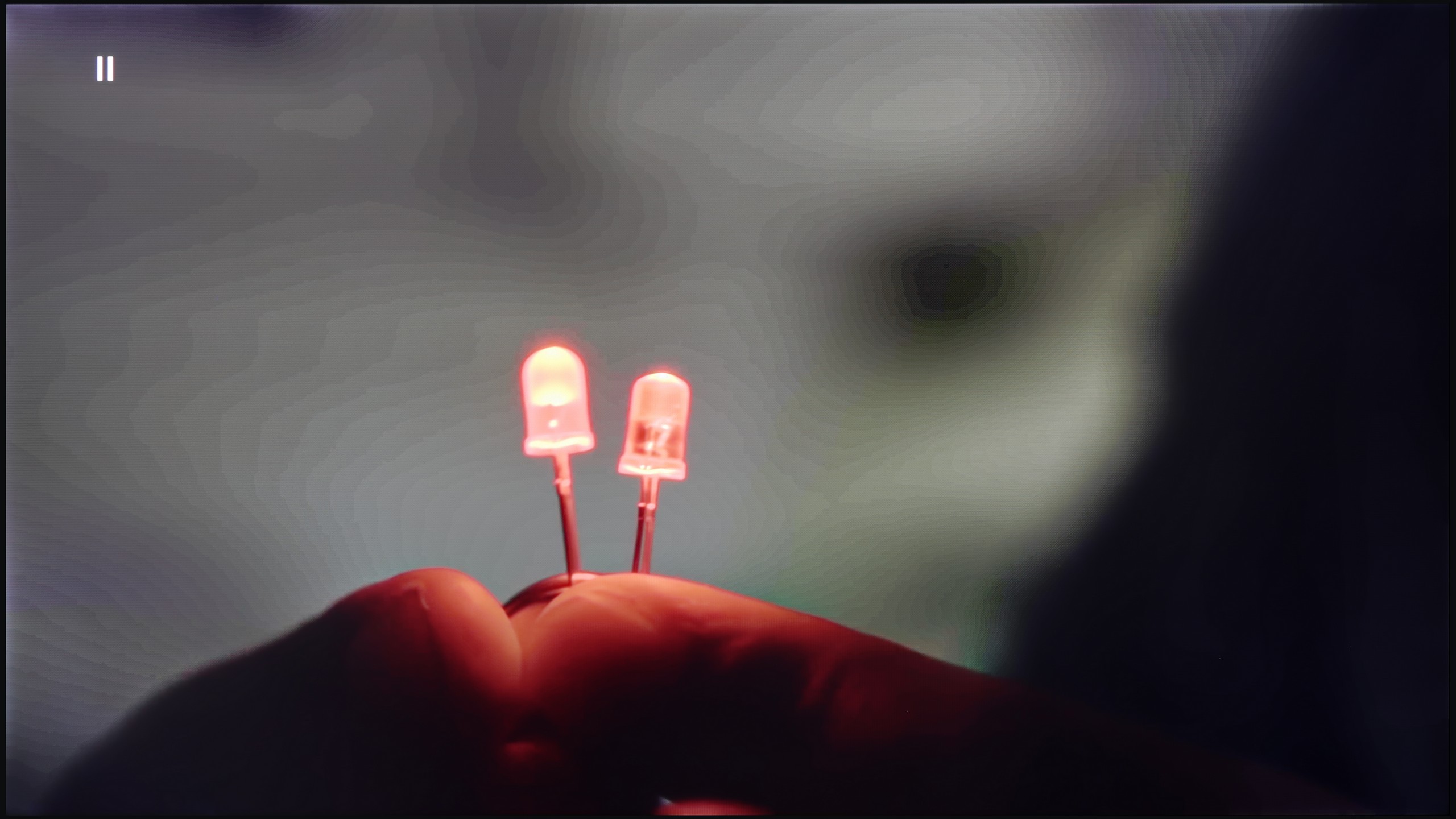
Image without overscan on the SD signal

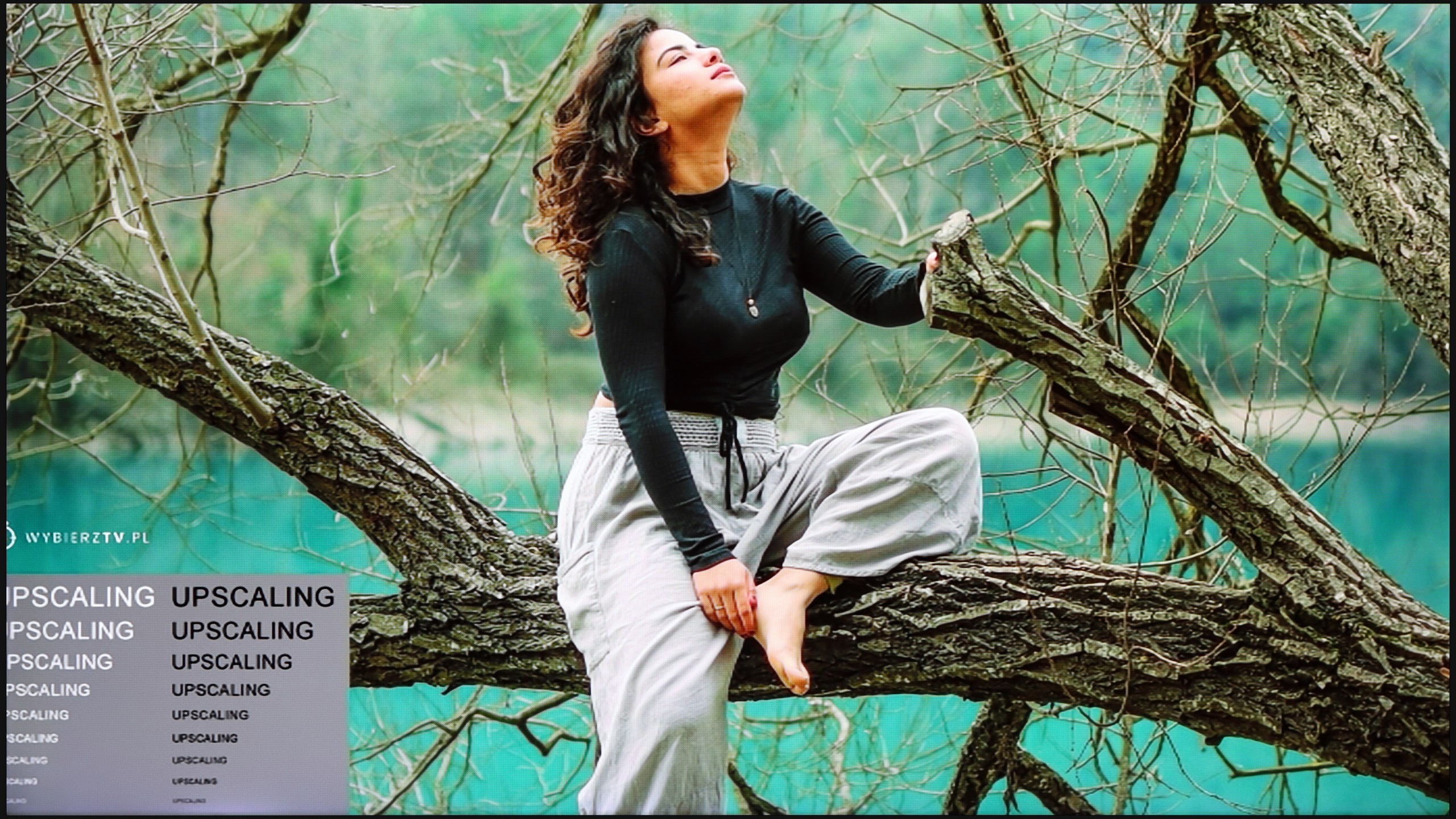
LG B5 really positively surprised us in terms of handling lower quality content. Thanks to the enhancement and smoothing features, materials in HD resolution or even SD gain a second life. Importantly – when this option is activated at the "low" or "medium" level, we do not feel that the image is artificially softened or smoothed out unnecessarily. Details remain intact, film grain does not disappear, and the edges of objects do not look washed out 😉. This is truly a useful tool – especially if you are watching terrestrial television, archival materials, or content from YouTube in lower resolutions. The image is clear, coherent, and simply pleasant to the eye.
Scaling as such works very well – even content of poor quality is reproduced with surprising fidelity. Unfortunately, there was a slight hiccup. Although the menu contains the option to disable overscan, the television still has issues with correctly displaying images of very low resolution. It may seem like a detail, but when watching older materials – it can be irritating.
LS03F has been equipped with the NQ4 processor, which is responsible for improving image quality – particularly in lower quality materials. In practice, this works surprisingly well, especially when it comes to older content and recordings with lower resolution. Activating the "noise reduction" function yields noticeable effects. The TV effectively smooths tonal transitions and removes digital noise that can appear in darker areas of the image. Compared to previous generations, there is a clear advancement – previously, this function often smoothed everything too much, including details that it shouldn't remove. In this year's model, smoothing still occurs, but in a much more acceptable manner. Textures of materials, skin, and fabric details are no longer subdued as strongly as before – the image retains more naturalness. However, this does not change the fact that film grain is still removed by the TV, which may not appeal to everyone. On the other hand, it is no longer as aggressive an intervention as in previous models. It is also worth mentioning that the LS03F may struggle with very weak signals – for example, from VHS tape recordings or low-resolution video. In such cases, we noticed slight clipping of the image at the edges – so-called overscan. This can lead to a situation where a small part of the image (e.g., subtitles at the bottom edge) gets cut off.
Blur and motion smoothness
8.5/10
6.9/10
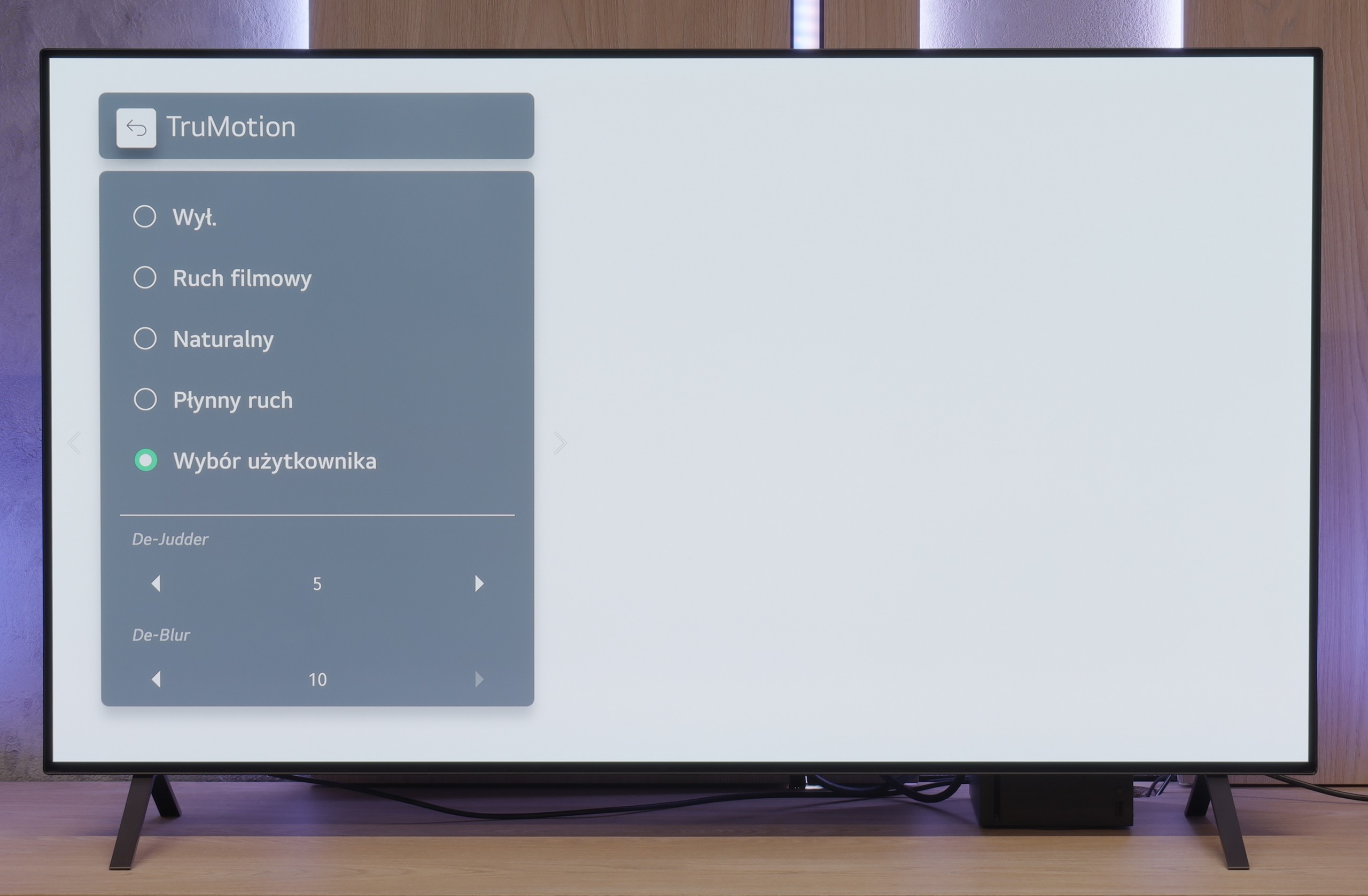
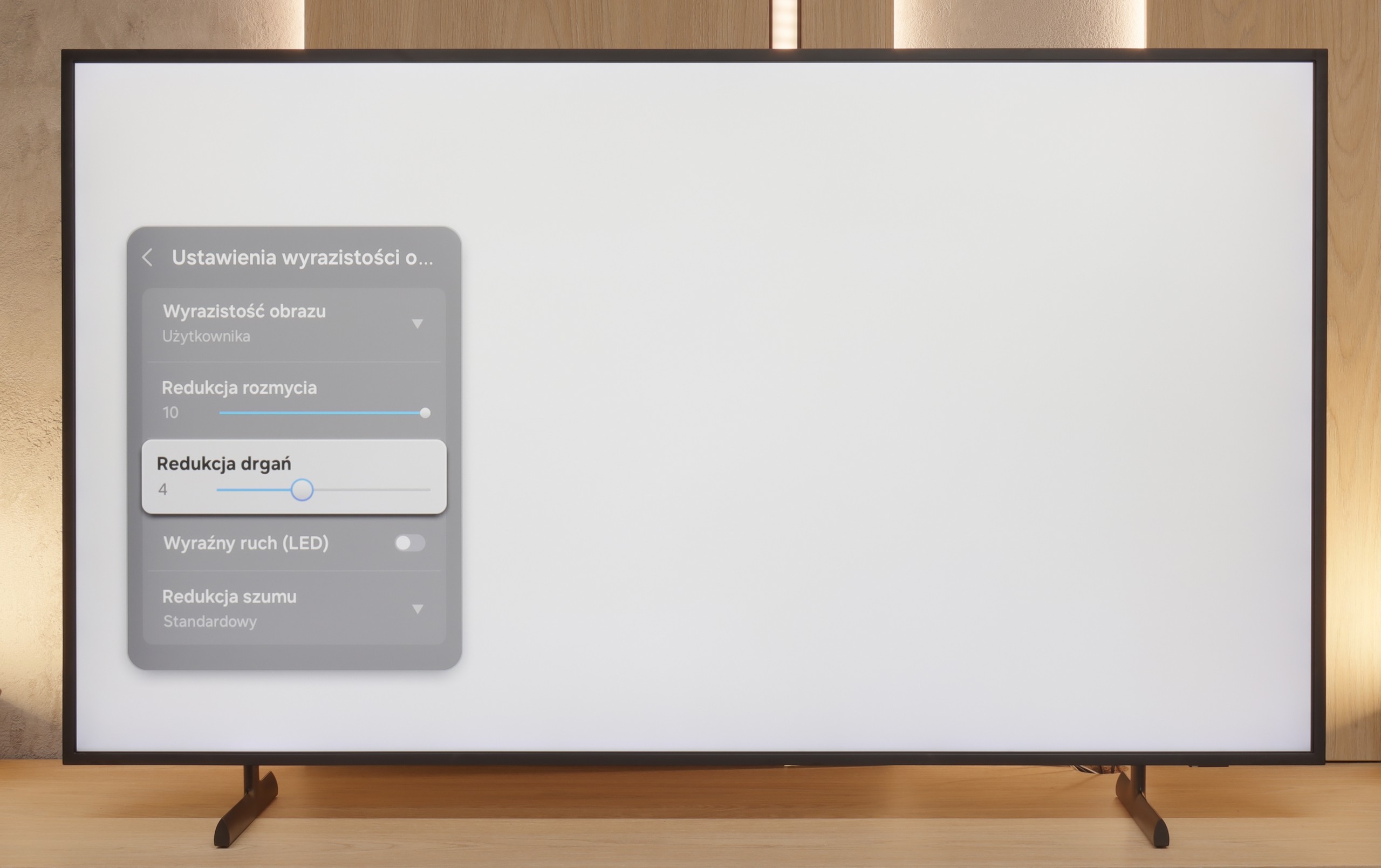
Blur (native resolution, maximum refresh rate):






Blur (BFI function enabled):
Image flickers in this mode



LG B5 is a television with a 120 Hz OLED panel. It may not sound as impressive as the marketing claims of “144 Hz” or “165 Hz” found in gaming monitors, but honestly? The smoothness is excellent nonetheless. The picture is sharp, fluid and simply enjoyable to watch – even when there is a lot happening on screen. The organic panel does its job – the pixel response time is almost instantaneous, meaning there’s no sign of smearing or blurring that can spoil dynamic shots. Sport, fast-paced games – everything looks clear and distinct.
We also have the classic LG smoothness enhancer, TruMotion. This allows you to smooth out films shot at 24 frames per second – which, to put it bluntly, is most of what you watch on Netflix or from Blu-ray discs. If you set lower values on the “De-Judder” slider, you’ll get a picture closer to a cinematic look – with a slight judder, but without any artificiality. Higher settings? A soap opera effect is guaranteed. Fortunately, LG gives you the option to tune everything to your liking.
The new feature in The Frame for 2025 is a display with a refresh rate of 144 Hz. Yes – in a television that is mainly associated with displaying works of art, you can now not only watch Van Gogh but also comfortably play on a console or follow dynamic sports events. This is a definite step towards greater versatility. In the case of Samsung films, as usual in models with a display rate of 120 Hz and above, it allows you to adjust motion smoothness according to your preferences. You can set a more cinematic reproduction while maintaining frame rate or opt for full motion smoothing. The range of options is broad, allowing you to tailor the effect to your own taste – whether the viewing experience is meant to resemble classic cinema or a show on a modern theatre screen.
*this part of the test refers to the LS03FAU model in sizes 55 and 65 inches, which is equipped with a 144Hz panel, while sizes 43 and 50 inches have 60Hz displays, and thus perform much worse in terms of motion smoothness.
Console compatibility and gaming features
10/10
8.1/10
- ALLM
- VRR
- VRR range40 - 120Hz48 - 144Hz
- Dolby Vision Game Mode
- Correct implementation of HGIG
- 1080p@120Hz
- 1440p@120Hz
- 4K@120Hz
- Game bar
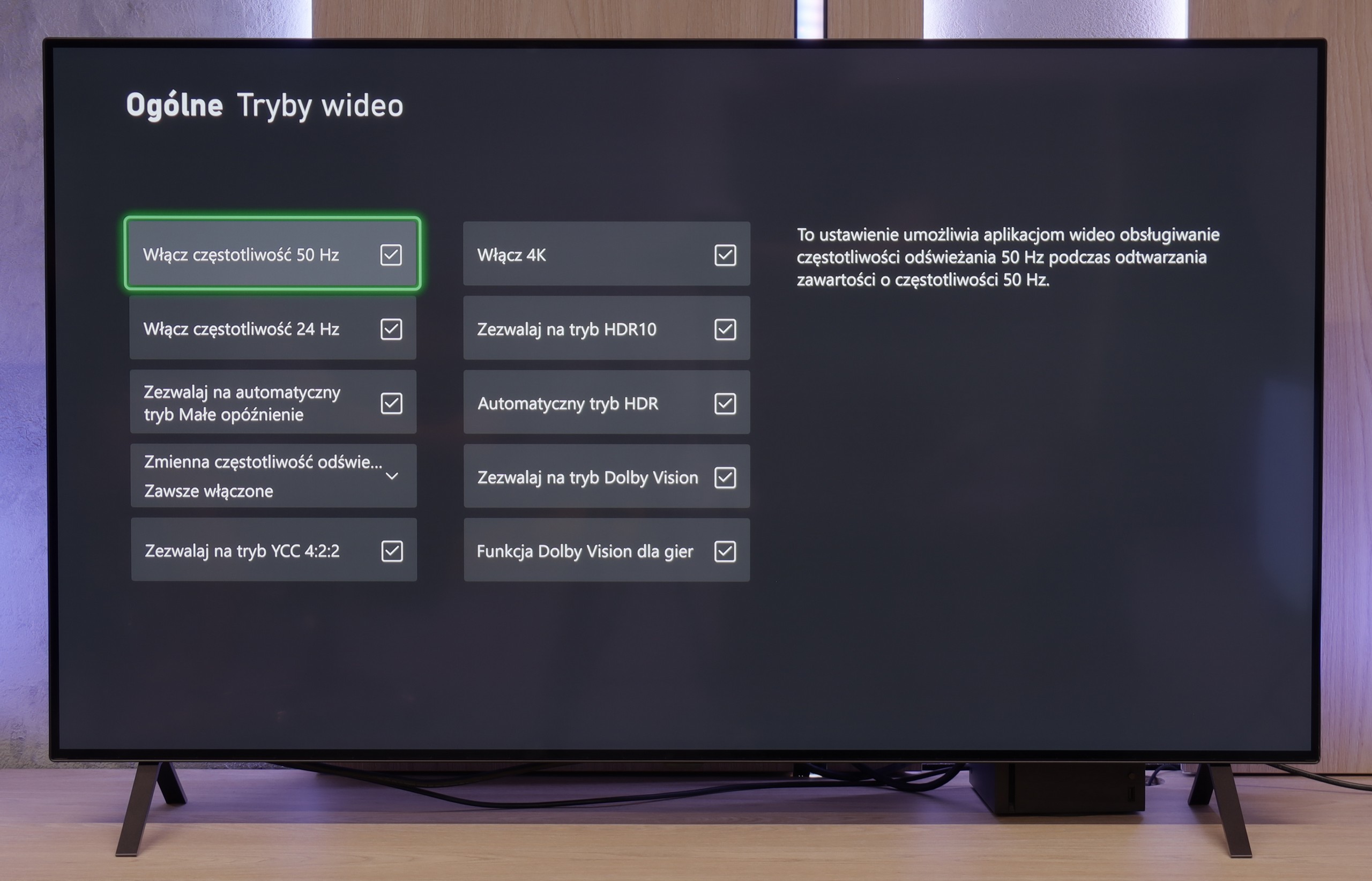
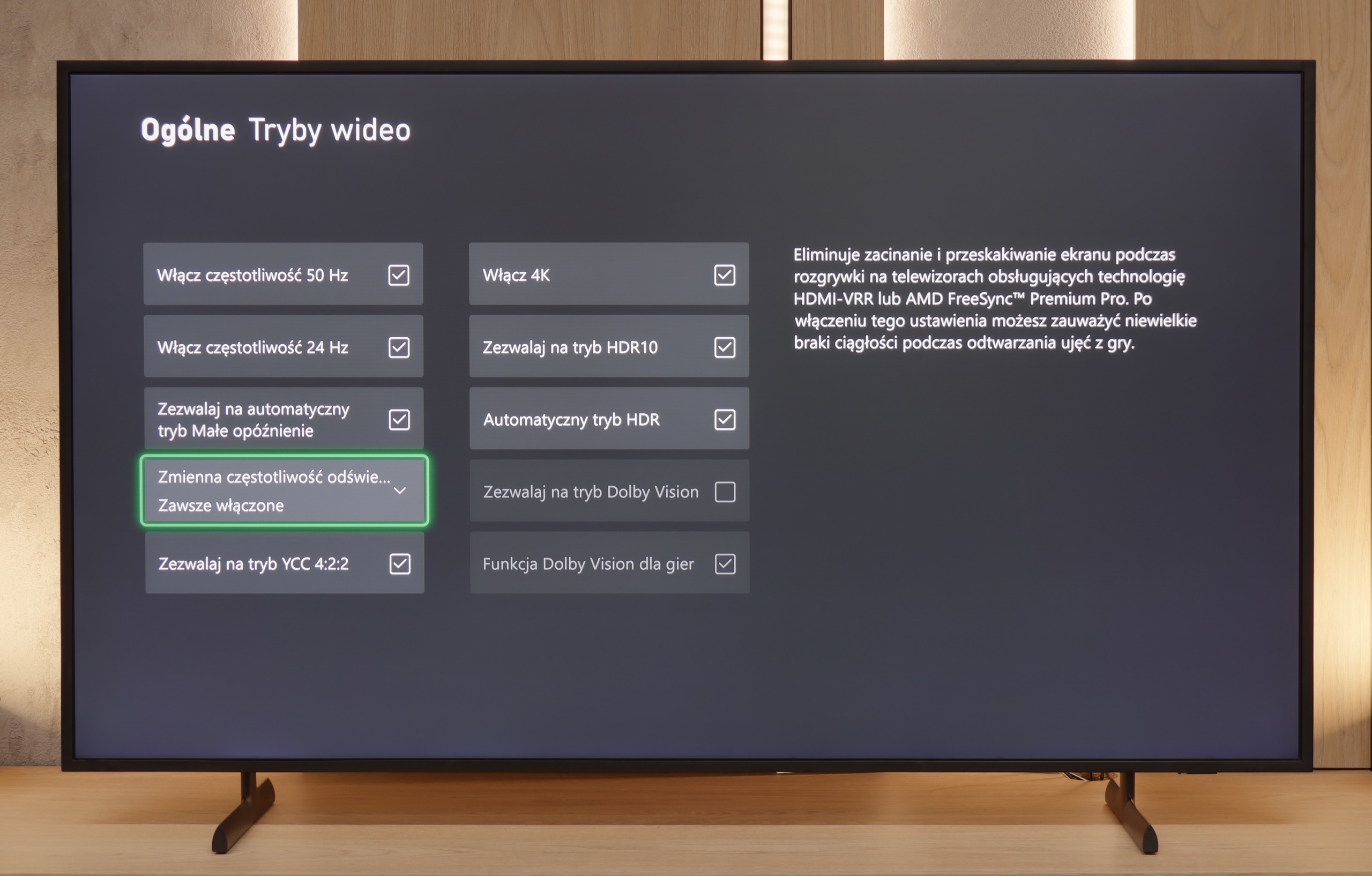
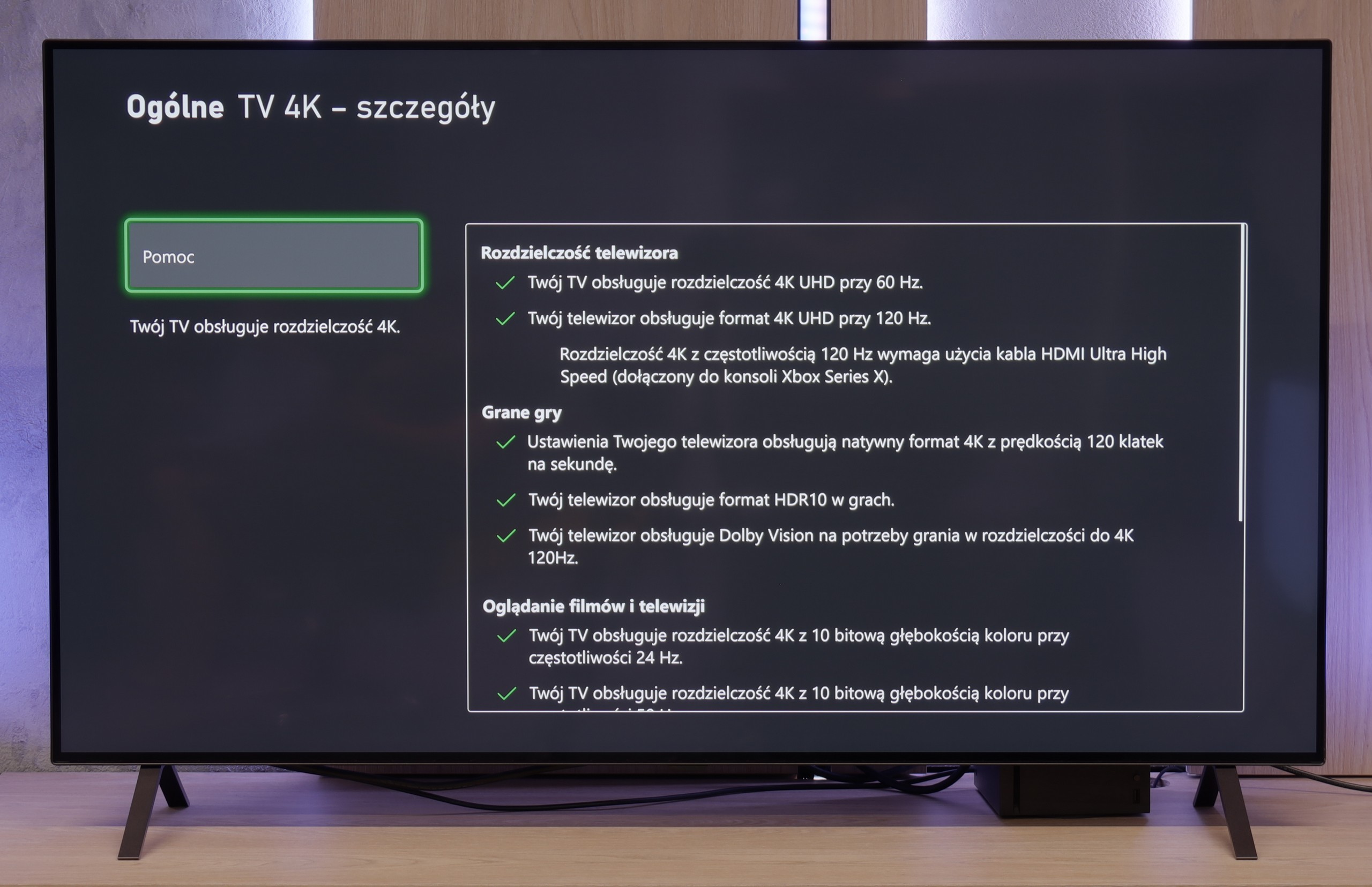
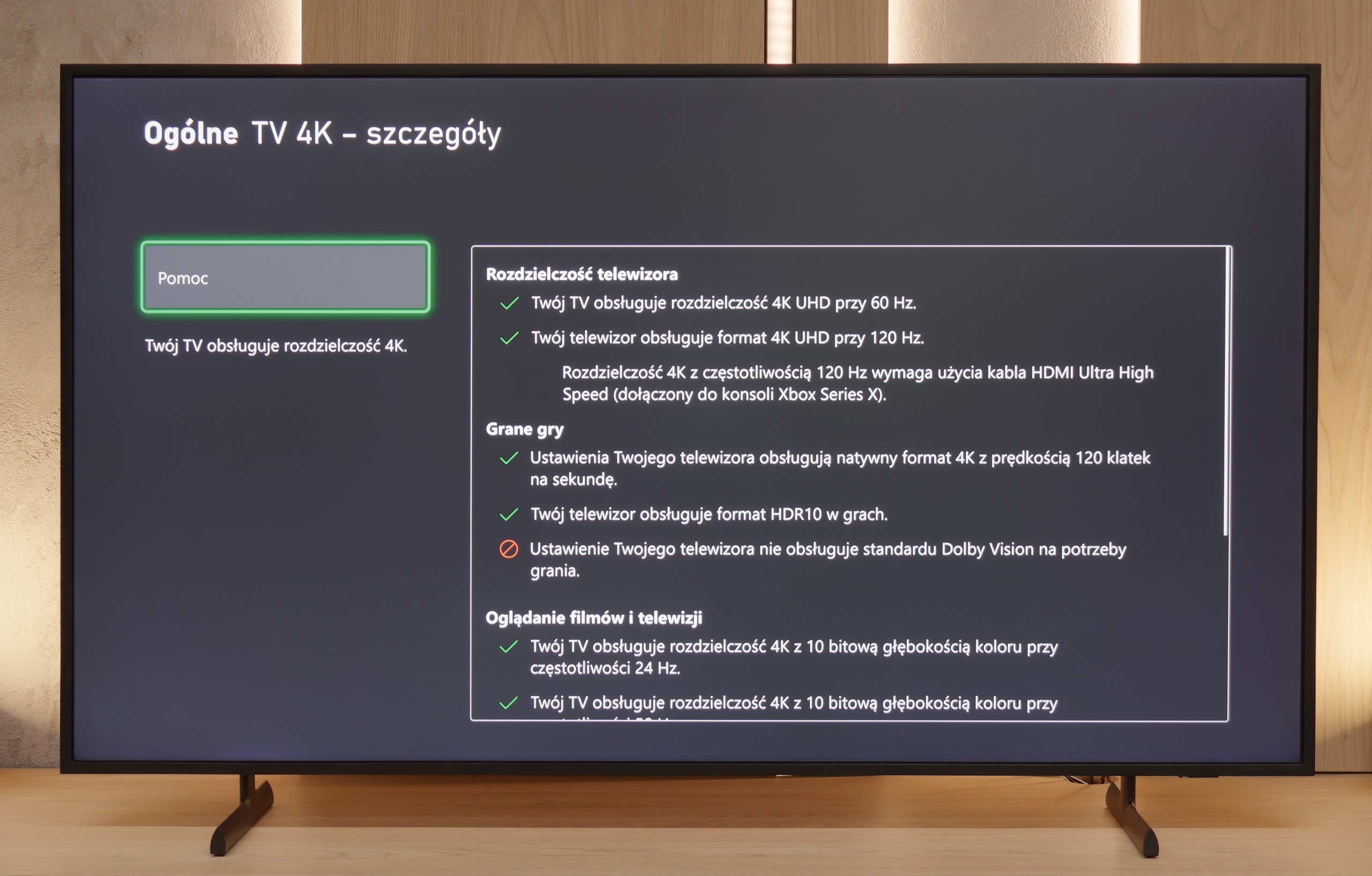
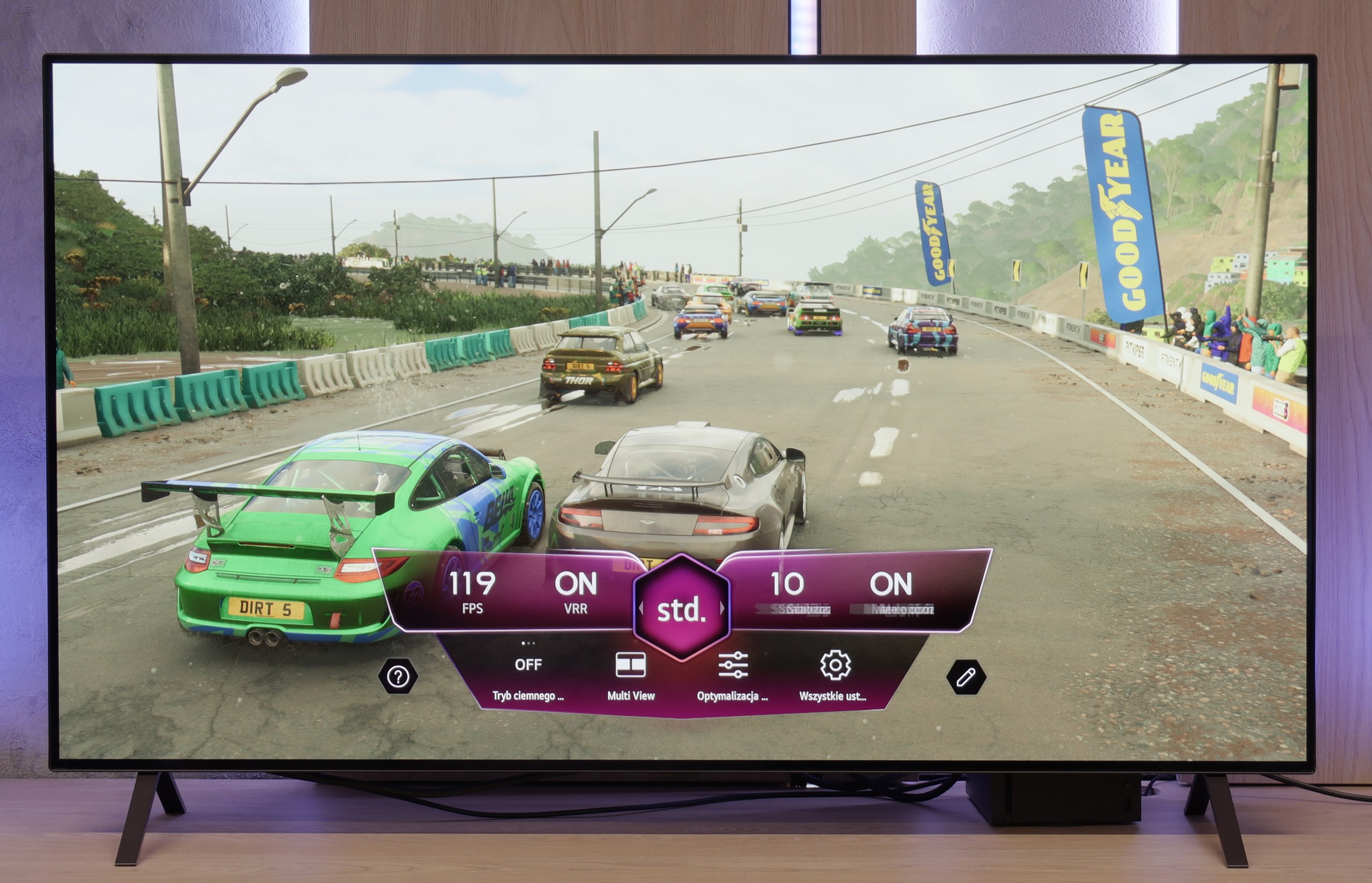

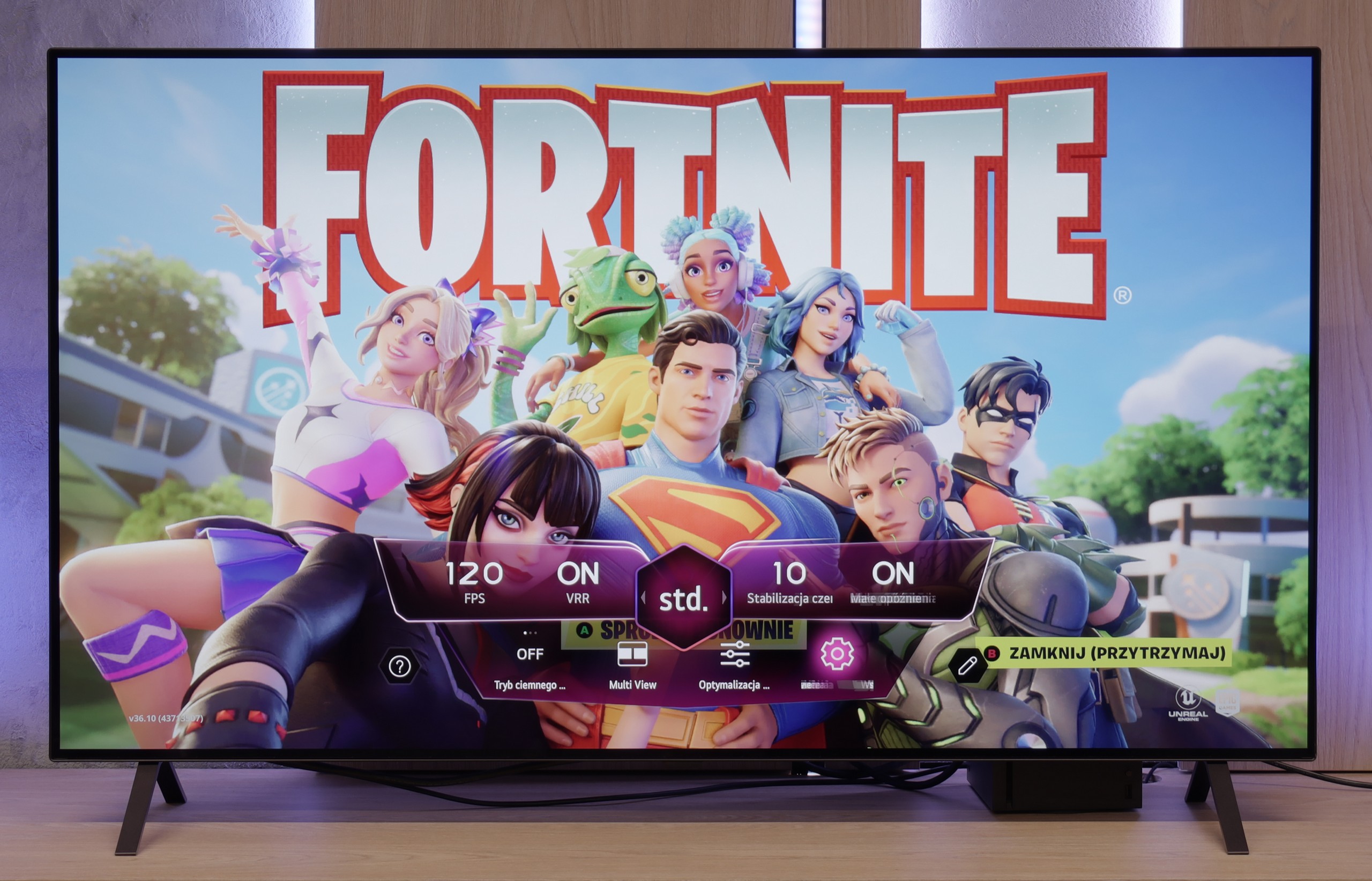
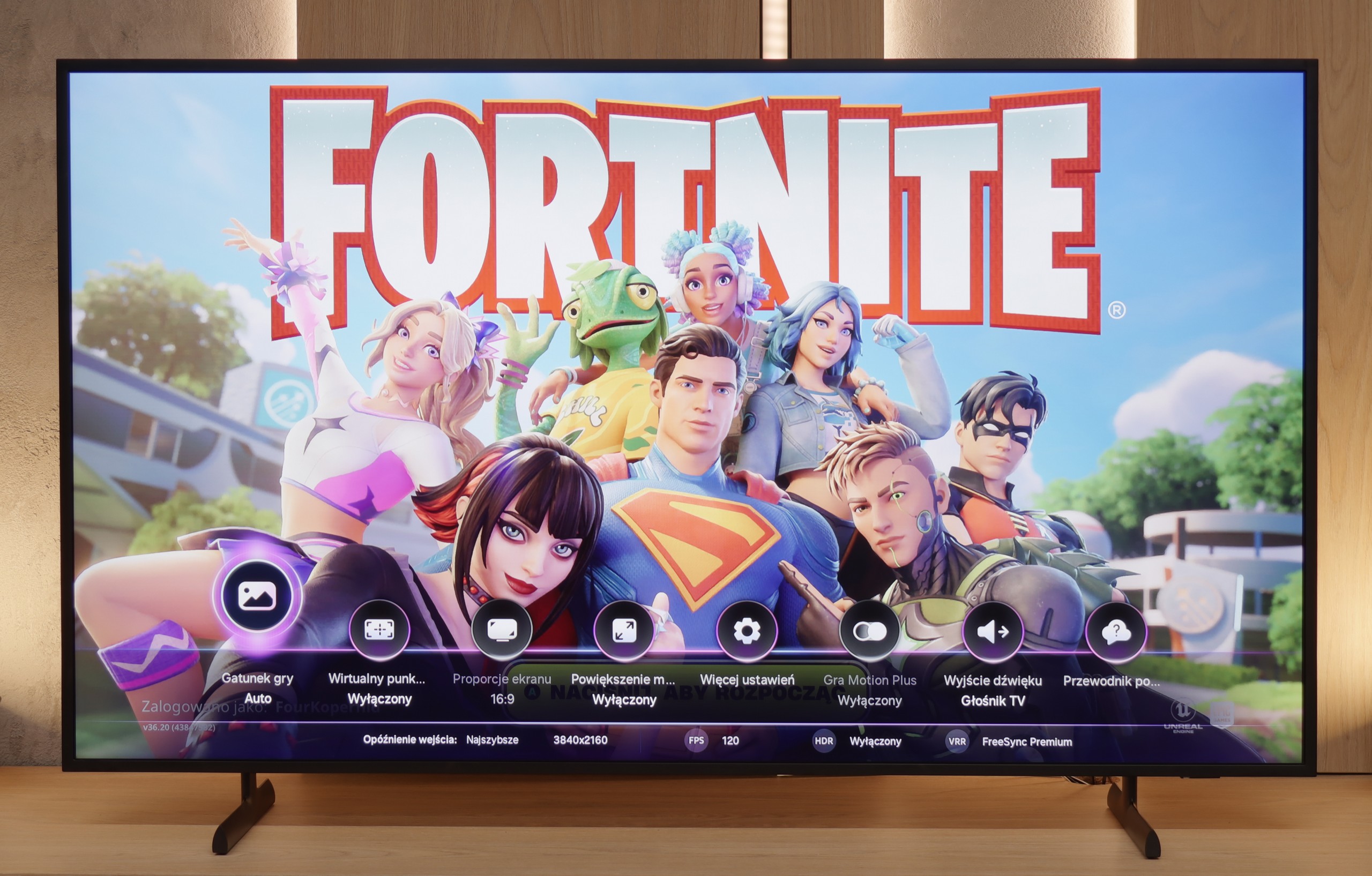
There are already a few televisions on the market with the label “for gamers” that, in practice, don’t understand what that means. The LG B5 is not one of them. Everything here is spot on – there are four HDMI 2.1 ports, it has 120 Hz, VRR, and ALLM, and it even has a Game Bar that is actually useful, not just looks good in the brochure. You connect your console – it works. You set 4K at 120 Hz – it works. You have an Xbox and want to play in Dolby Vision – it works too. And this is not in the sense of “theoretically supports”; it really turns on, looks good, and you don’t need to fiddle with the settings for half an hour. Additionally, there’s the HGiG picture mode that LG implemented correctly – which means HDR in games doesn’t turn the screen into a flash lamp, but shows exactly what it should. There are no surprises here, no strange limitations, no “buts.” And you know what? That’s how it should be. Cheers to the LG B5!
As we mentioned earlier – although The Frame is likely to display images and works of art most of the time, Samsung recognised that a Van Gogh enthusiast could just as easily be an avid gamer. And it must be admitted that The Frame 2025 has almost everything needed to become a full-fledged gaming television.
On board, we find support for ALLM (Automatic Low Latency Mode) and Variable Refresh Rate (VRR) thanks to the implementation of one HDMI 2.1 port. The television handles lower resolutions at higher refresh rates effortlessly and features an advanced Game Bar – already known from other Samsung models – which allows for a quick preview and change of the most important gaming-related settings. For this, it earns extra points from us. The proprietary motion smoother Auto Motion Plus Game is also worth mentioning, which – it is worth emphasising – operates without increasing input lag. Samsung remains the only manufacturer that has managed to implement this feature in a practically invisible manner in terms of delays. The effect? Much better fluidity in games, especially those that struggle to maintain a stable 60 frames per second. This solution can realistically improve the gaming experience in more demanding titles – particularly on consoles, which do not always manage full fluidity, especially in AAA games.
As for the downsides – the lack of Dolby Vision is already considered standard in Samsung televisions, so there is not much to particularly criticise here. However, there is a different issue entirely. In the latest version of the Tizen system, the HGiG option has disappeared. Literally – it is not there. This is a significant hindrance when configuring the console for proper HDR content display in games. It is hard to understand why such a decision was made, but one thing is certain – this should be fixed as soon as possible. We are talking about a brand that has set standards for gaming on televisions for years. If HGiG returns – and we hope it will – The Frame LS03F can confidently aspire to be called a genuine gaming television. Not just as a decoration on the wall, but as equipment that truly provides joy in gaming.
Input lag
9.9/10
10/10
SDR
HDR
Dolby Vision
Here we won't elaborate – the LG B5 simply has excellent input lag. For 60 Hz content, it achieves results below 10 ms, and for 120 Hz it even drops to around 5 ms. These are values that cannot be fairly critiqued. It simply works instantly, with no delays, no surprises. Well… almost. Because as usual, there is a small asterisk with the Dolby Vision Gaming mode. In this mode, the response time slightly increases. It’s nothing dramatic – they are still very low values, hardly noticeable during gameplay – but if you play exclusively competitive titles and fight for every millisecond on the XBOX, it’s worth keeping in mind.
In terms of input lag, Samsung maintains a high level – and a very high one at that. The LS03F, like most of this year's models from the brand, achieves a score of 8 ms for 4K content, which is practically a reference value. This result allows for gaming even in the most dynamic titles without delays and with full responsiveness. Well done!
Compatibility with PC
7.6/10
8.2/10
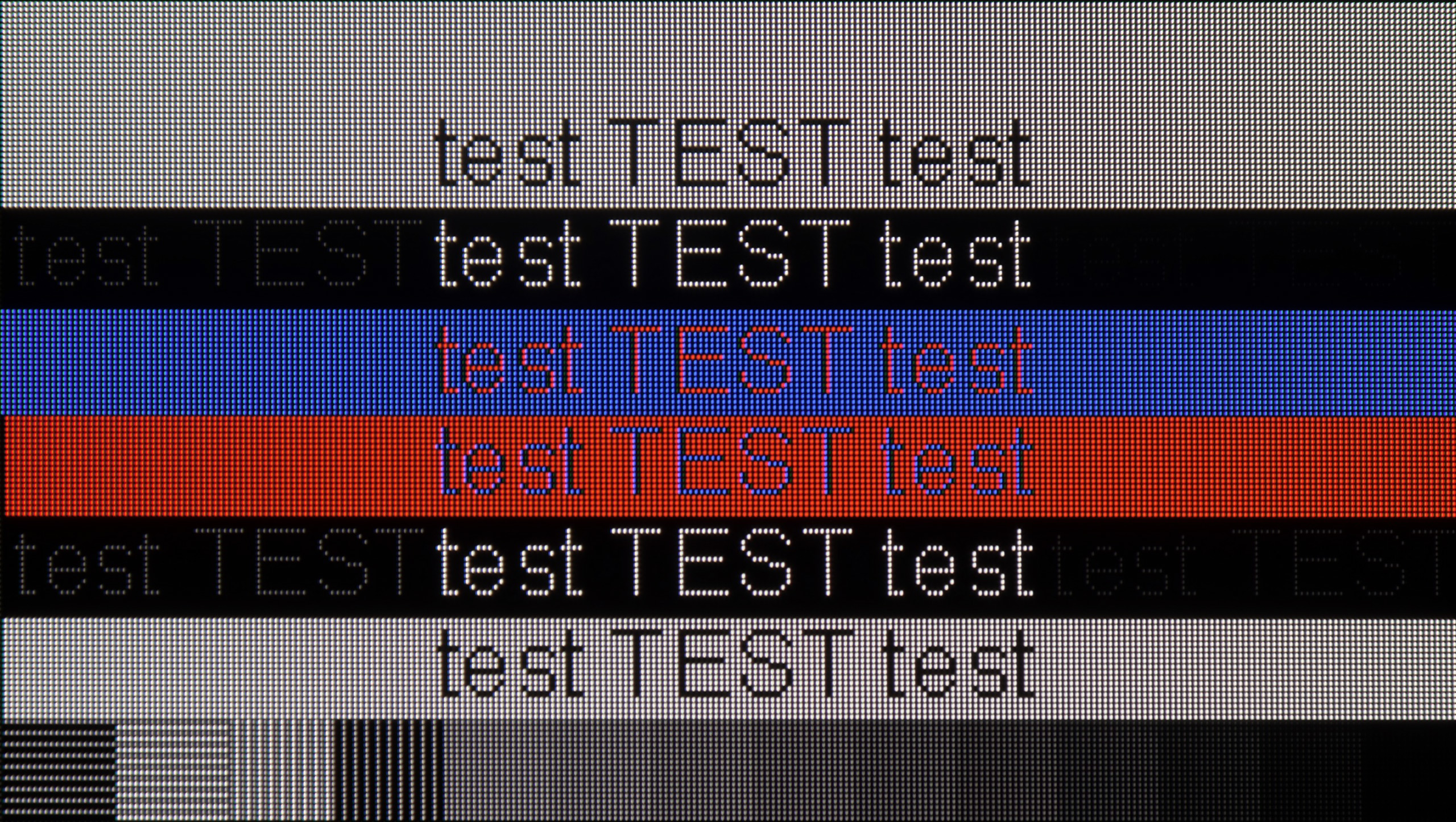

LG B5 is a television that communicates well with a computer. You won't find gaming frills like 144 or 165 Hz here, but is that really necessary for anyone? Thanks to the 120 Hz panel, low input lag, and G-Sync support, it's truly a very good screen for gaming on PC. No stuttering, no tearing, with lightning-fast response.
But it's not just for gaming. You can also quite comfortably... simply work on the B5. The television properly supports chroma 4:4:4, so fonts are readable, interfaces are clear, and your eyes won't hurt from blurred letters. This isn't a given, even among more expensive models. However, there is one 'but' – and this applies not only to the B5, but to any OLED with a WOLED panel. The RWGB subpixel arrangement can cause a slight shadow along the edges of fonts. This isn't something that stands out from the sofa. It's something that someone sitting with their nose to the screen and spending half the day in Excel would notice.
The collaboration of The Frame 2025 with a computer is not a significant problem. Let's start with gaming, as this is where this model demonstrates its strengths – support for 144 Hz signal, low input lag, and compatibility with G-Sync technology (for NVIDIA cards) make it hard not to regard it as a fully-fledged gaming monitor. It is one of the more interesting "PC gaming" televisions available on the market in this category.
When it comes to everyday work, the situation looks equally good. The Frame handles chroma 4:4:4 without any issues, resulting in good font readability and overall user comfort. We only noticed minor problems with dimming very thin lines and dark details on a light background – this effect may occur especially when working with small interface elements. However, in practice, with a 55-inch diagonal screen and standard office working distance, it will be difficult to realistically notice this problem. Nonetheless, it is worth keeping this in mind if the television is to serve as a monitor not only for entertainment but also for precise work with graphics or text.
Viewing angles
7.4/10
3.5/10
In terms of viewing angles, the LG B5 performs very well – exactly as one would expect from an WOLED panel. No matter from which side you sit, the picture maintains its quality. The colours do not wash out, the contrast does not deteriorate, and the details remain clearly visible. However, it must be said that this is not the level of Samsung Display's QD-OLEDs. Those can hold colour saturation even better at extreme angles. But if you do not plan on watching films while sitting at a 90-degree angle – the B5 is more than sufficient. It is one of those televisions that is simply pleasant to look at – from every angle.
As could be expected from a VA panel, the viewing angles on The Frame 2025 are at best mediocre. The image loses saturation and contrast when moved off-axis. It's a pity because we are talking about a model that displays digital artworks in standby mode – and it is precisely in such moments that wide viewing angles would make the most sense, enhancing the experience of engaging with a real image rather than just its screen imitation.
Perhaps in the future, manufacturers will decide to introduce special coatings or modified versions of VA panels that improve this aspect – because for lifestyle televisions, it would have real significance not only in terms of functionality but also aesthetics.
TV efficiency during daytime
4.9/10
6.3/10
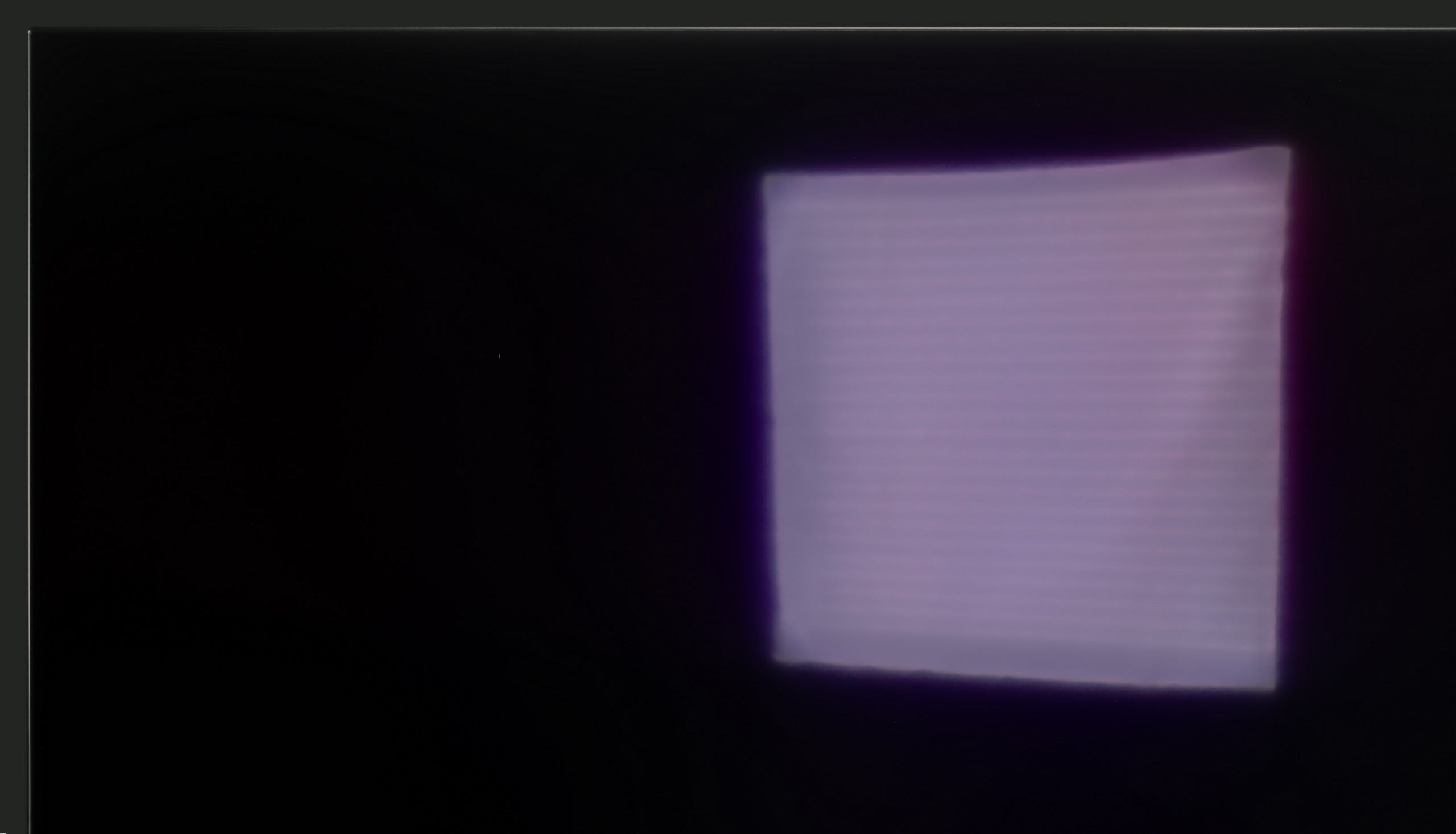
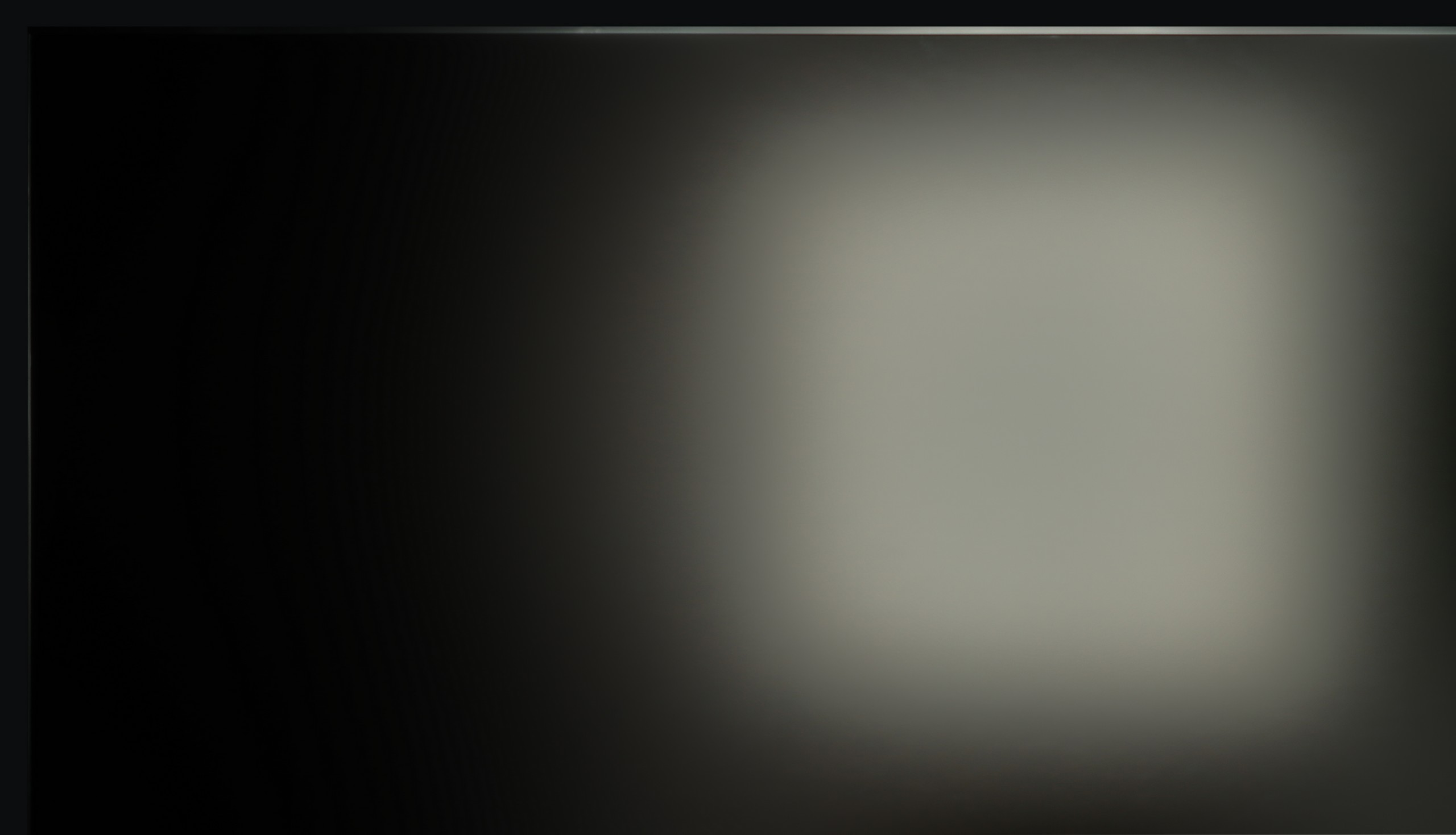


Matrix brightness
Average luminance SDR
Samsung The Frame 2025 (LS03F): 596 cd/m2
LG OLED B5: 279 cd/m2
LG B5 is a television that feels best after dark. But when the sun comes out, it becomes a challenge. The brightness of this model is rather average, and the anti-reflective layer... also average. There are no special coatings here that handle reflections or very bright daylight well. So if you plan to place this television opposite a large, uncovered window – it could simply be difficult to see anything.
Fortunately, there is something worth praising: the glossy WOLED panel maintains colour saturation well. Even in difficult conditions, the image does not fade and does not become "washed out," as can happen with some models of televisions. Generally, it is watchable, but if you are looking for a television specifically "for a bright living room," then the B5 should not be your first choice.
One of the most characteristic elements of The Frame is its matte display – and it must be said that Samsung has really refined this aspect. From our experience, it is one of the best solutions for suppressing light reflections, especially direct ones. If screen reflections can be irritating, it will be difficult to find a better display in this budget than the matte panel used in Samsung TVs. Of course, this comes with a certain compromise. In very bright sunlight, colours may appear slightly washed out, and the image loses a bit of depth. However, it is something we consciously accept when choosing a matte screen – something for something. In practice, the colours and contrast on Samsung's matte screen are still better than on Chinese designs such as the TCL NXT Vision or Hisense Canvas TV. If effective suppression of reflections and the desire to use the television also as a "digital picture" in bright rooms is a priority, then there is hardly a better choice.
The Frame achieves around 600 nits of brightness, which combined with the matte finish allows the television to perform well in brightly lit daytime conditions. It may not be at the level of flagship models, but in everyday use – in a living room with plenty of light – it handles it without any problems.
Details about the matrix
Subpixel Structure:
Panel uniformity:
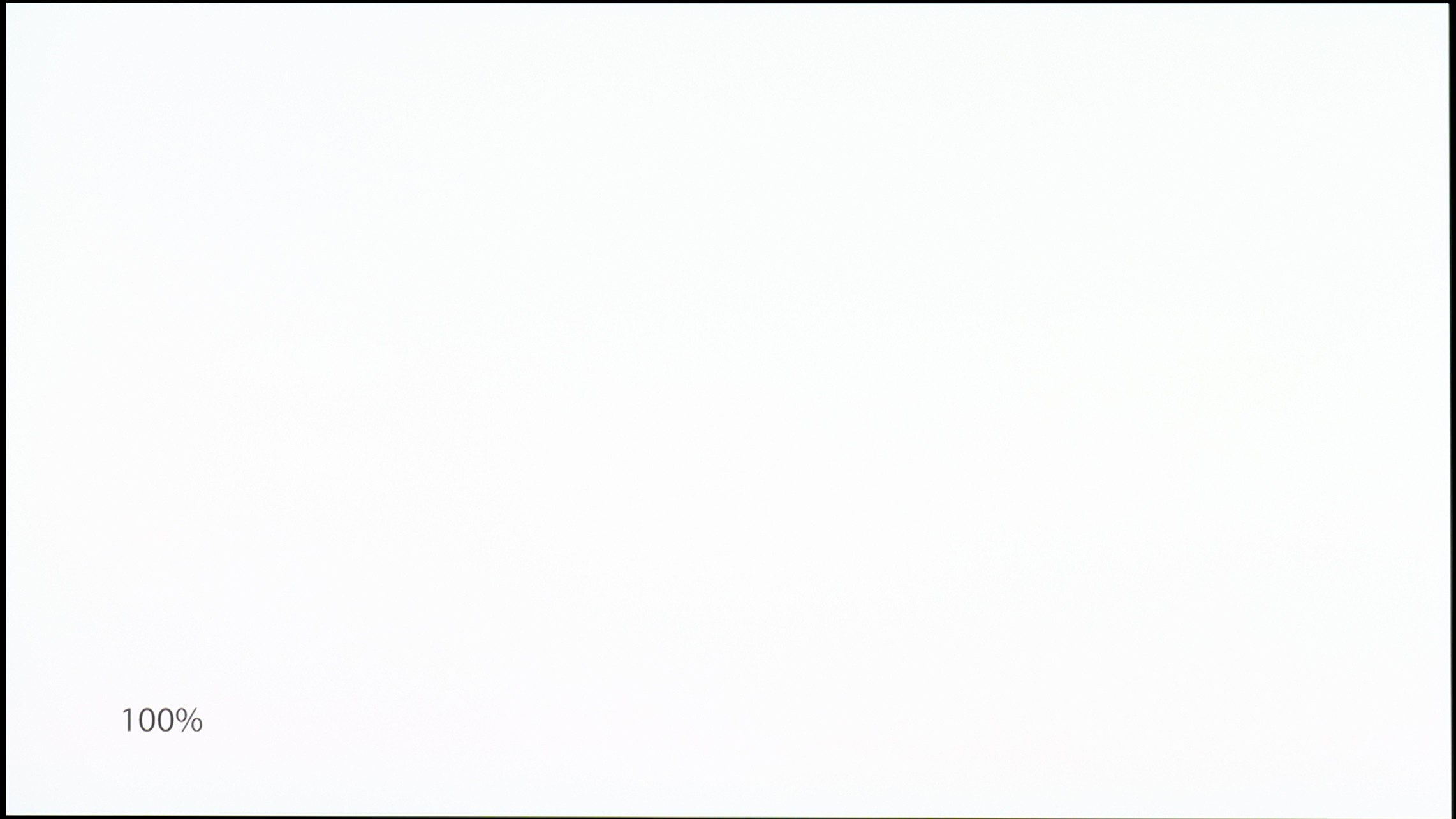
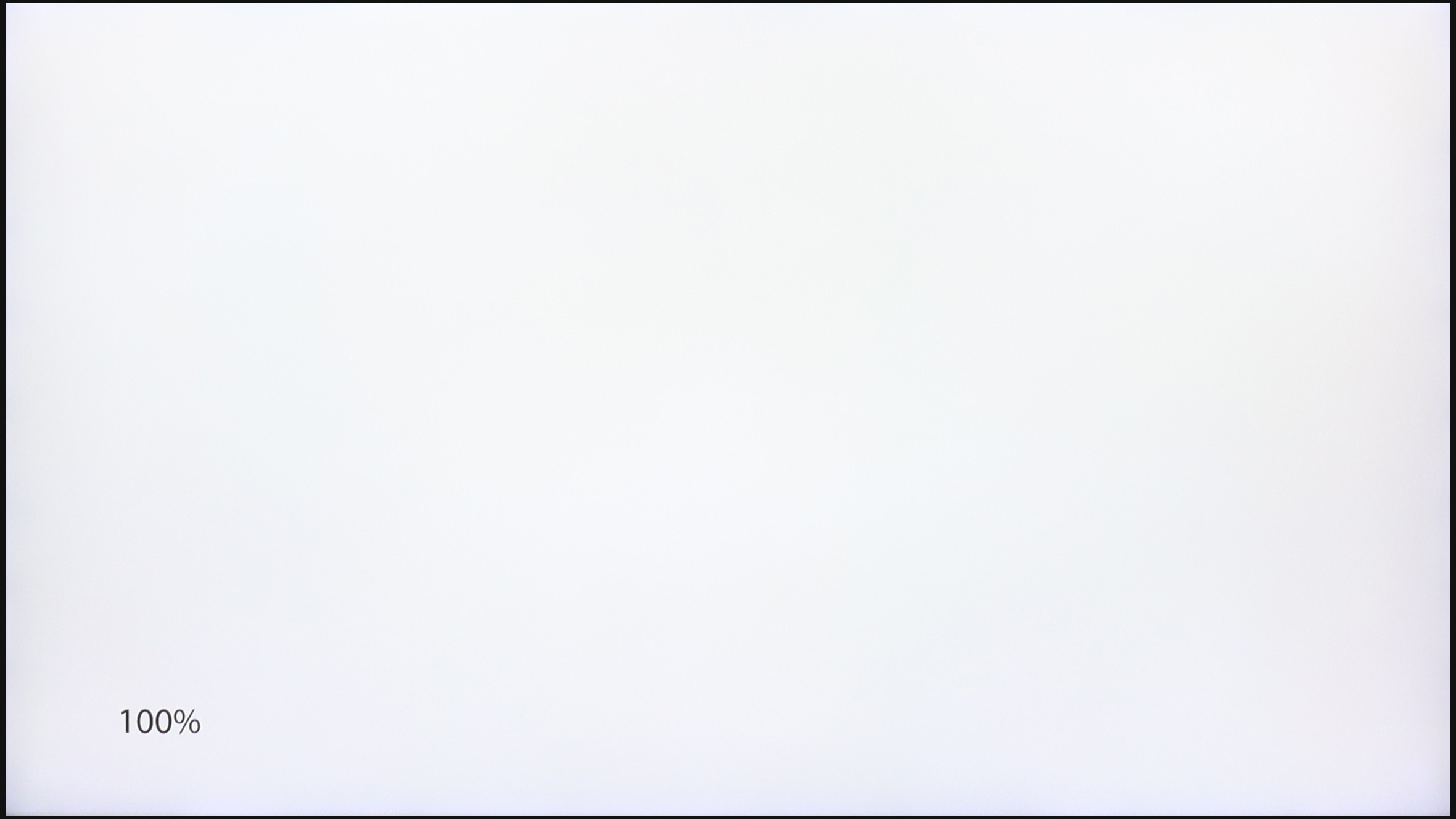
TV features
8.3/10
8.1/10
- HDMI inputs0 x HDMI 2.0, 4 x HDMI 2.1 48Gbps3 x HDMI 2.0, 1 x HDMI 2.1 40Gbps
- OutputsToslink (Optical audio), eARC (HDMI), ARC (HDMI)Toslink (Optical audio), eARC (HDMI), ARC (HDMI)
- Network InterfacesWi-Fi 2.4GHz, Wi-Fi 5GHz, Ethernet (LAN) 100MbpsWi-Fi 2.4GHz, Wi-Fi 5GHz
- TV receptionDVB-T, DVB-T2, DVB-S, DVB-S2, DVB-CDVB-T, DVB-T2, DVB-S, DVB-S2, DVB-C
Classic features:
- Recording to USB (terrestrial TV)
- Recording programming
- Picture in Picture (PiP)
- RF remote control (no need to aim at the screen)
- Backlit remote control
- Teletext
- Audio only mode
- Possibility to connect Bluetooth headphones to the TV
- Possibility to simultaneously use Bluetooth headphones and the TV speaker
Smart features:
- AirPlay
- Screen mirroring (Windows Miracast)
- Wyszukiwanie głosowe
- Voice search in native language
- Ability to connect a keyboard and mouse
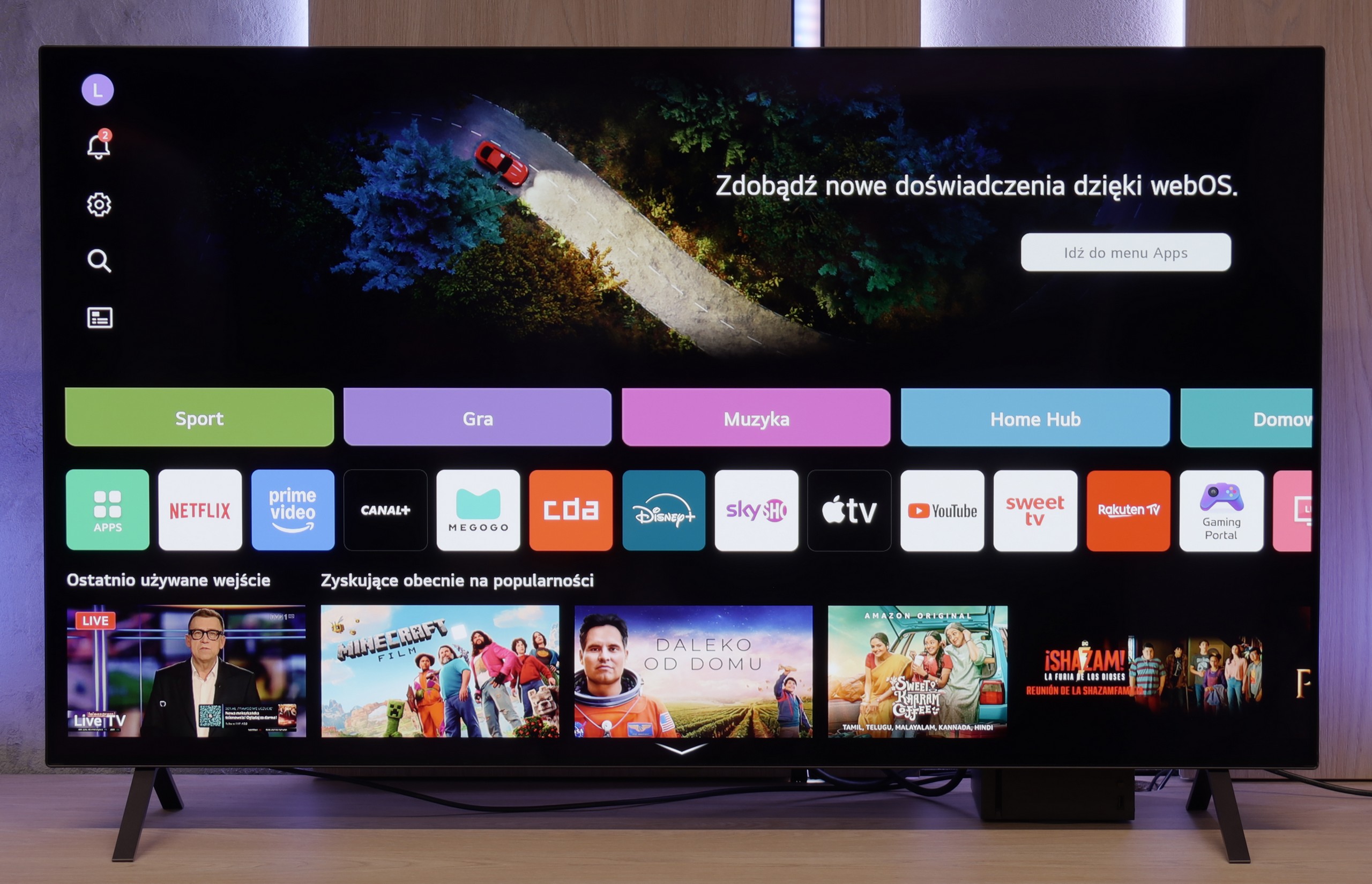
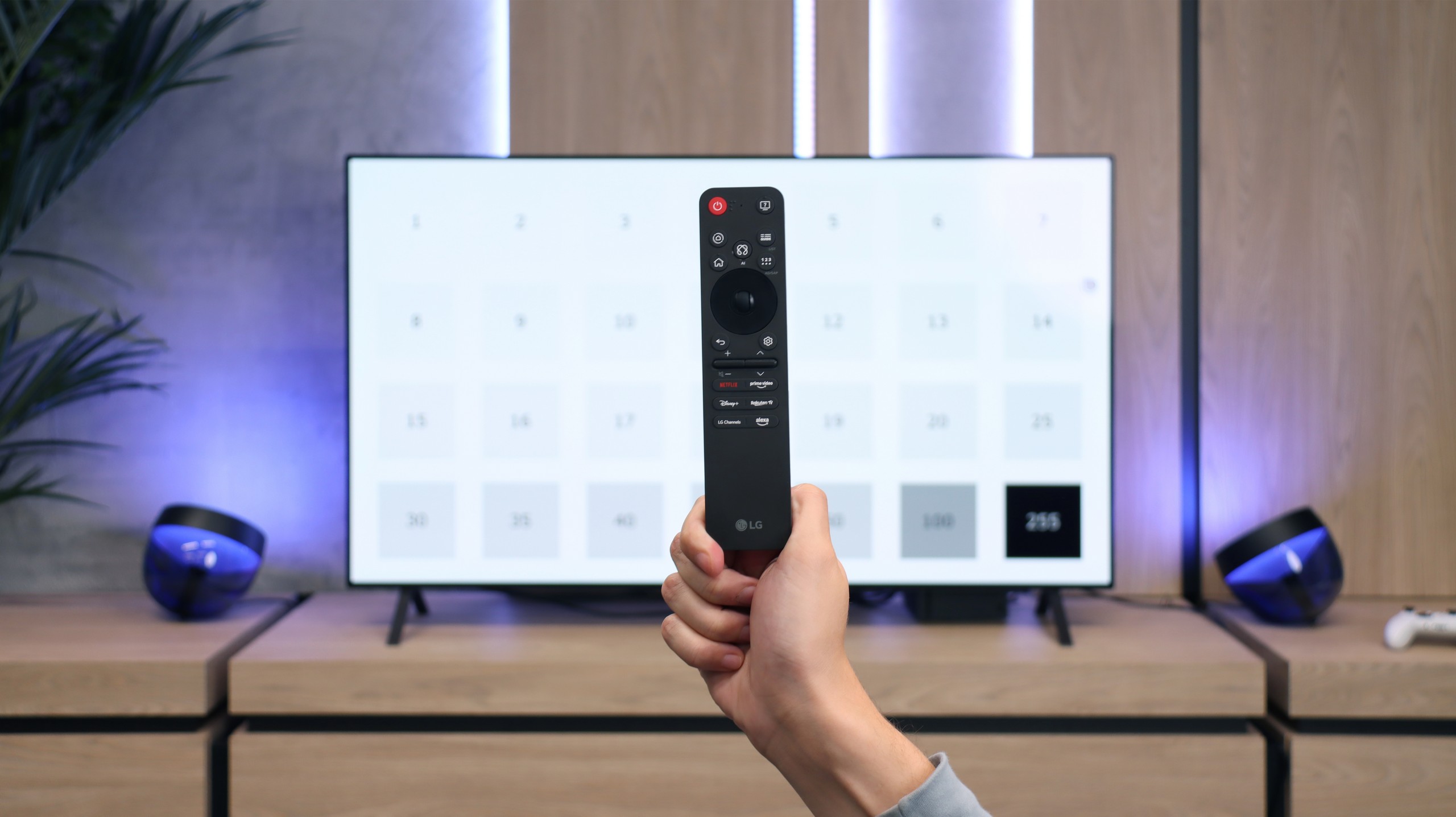
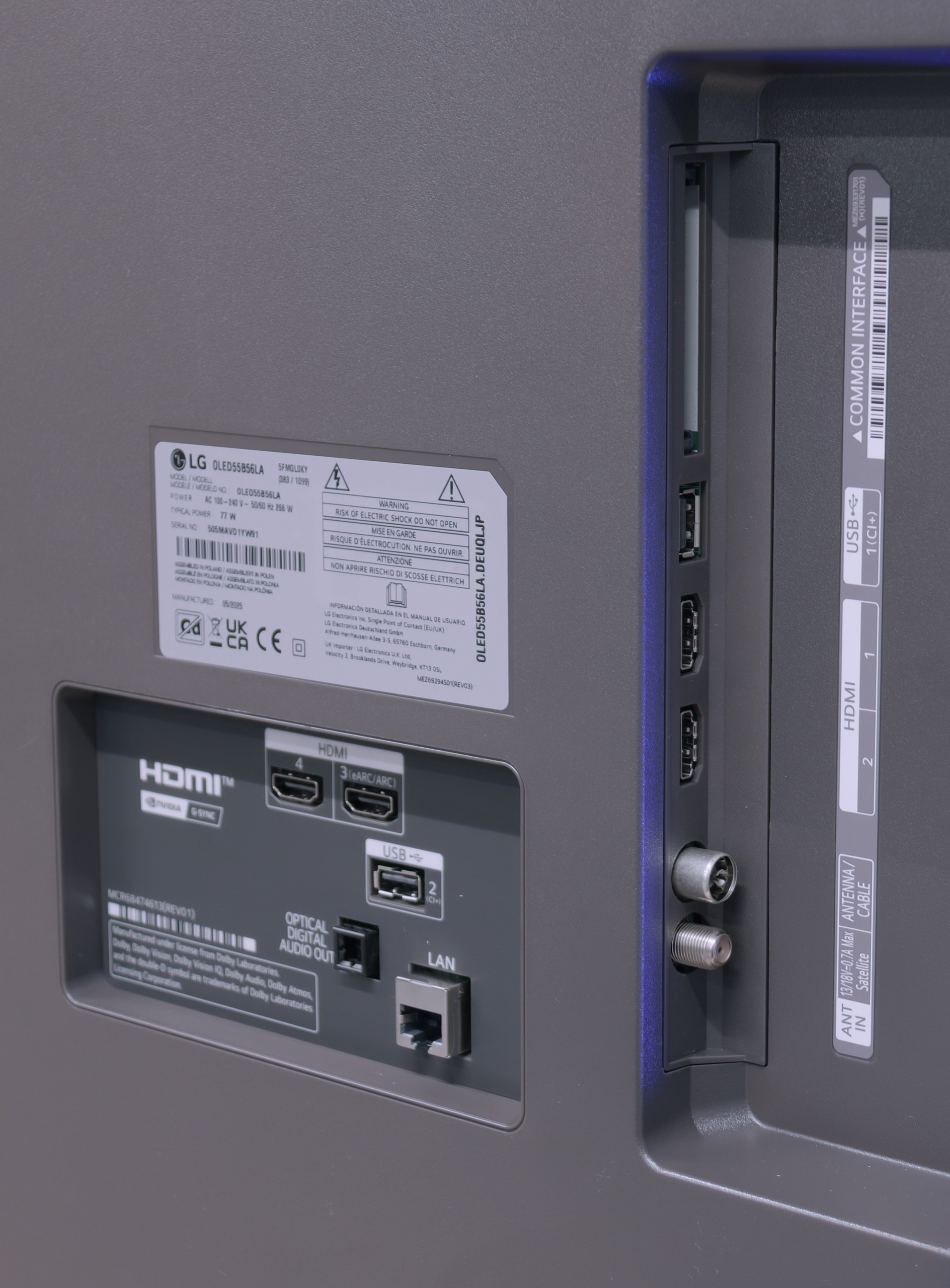
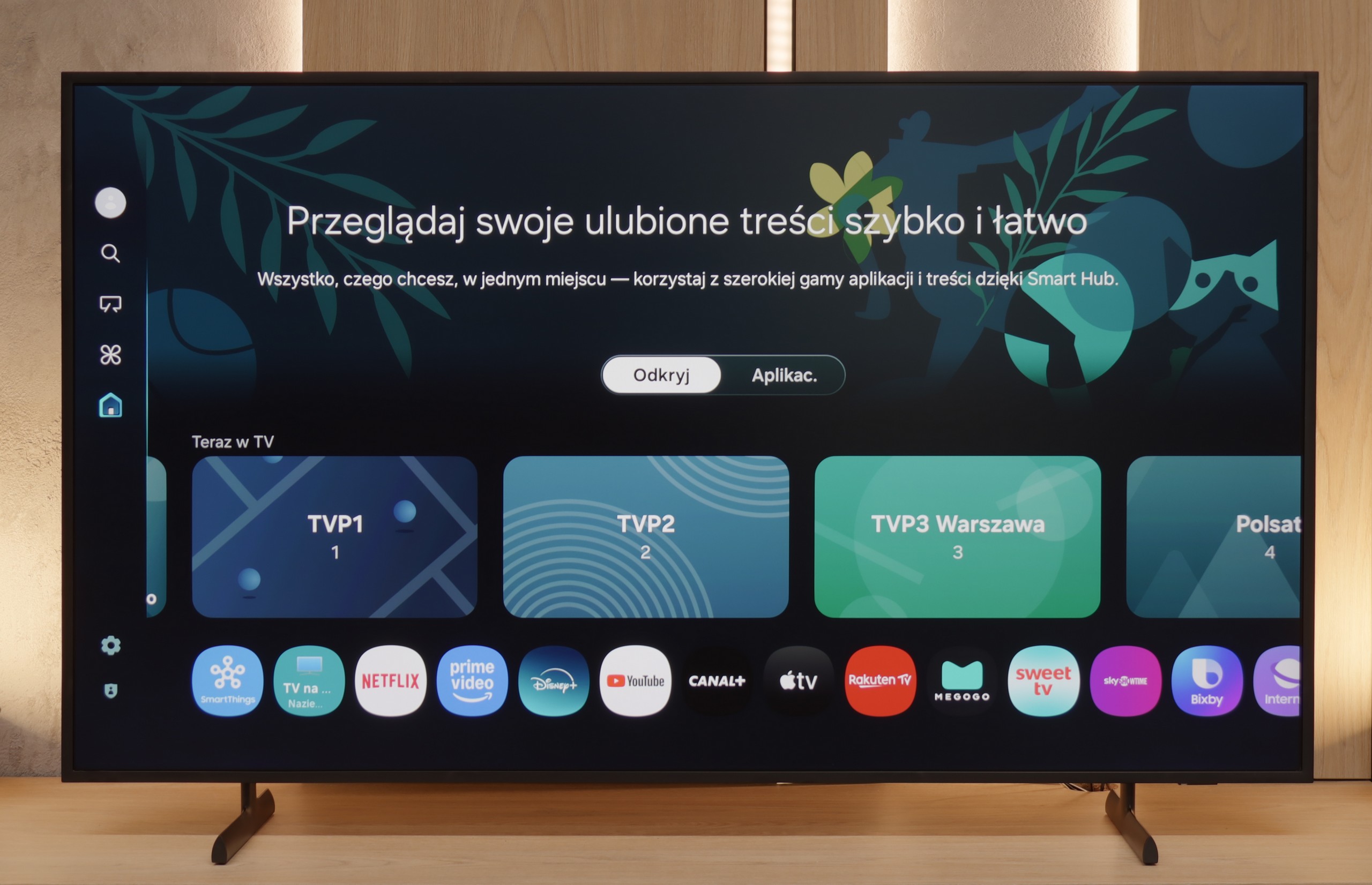
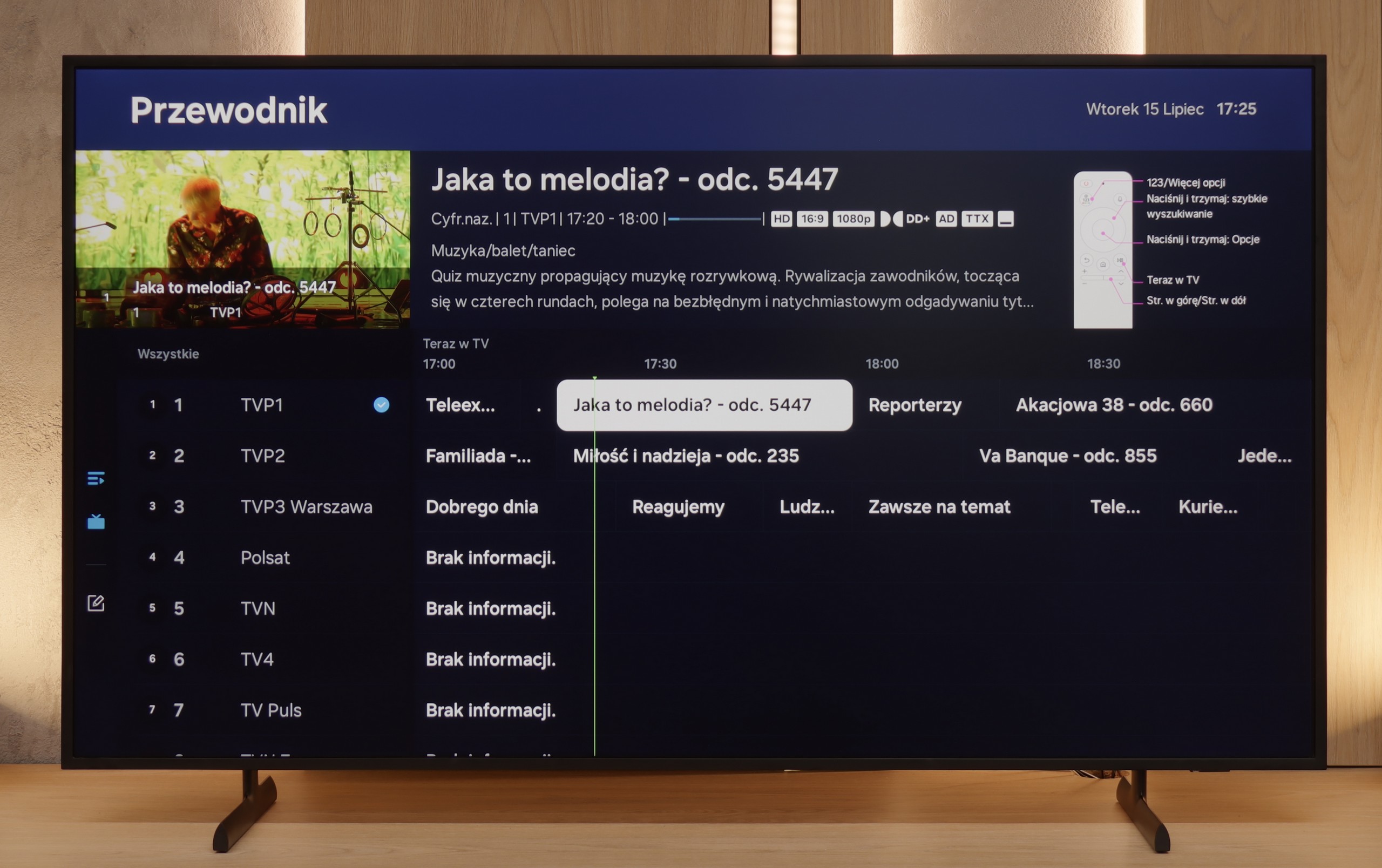

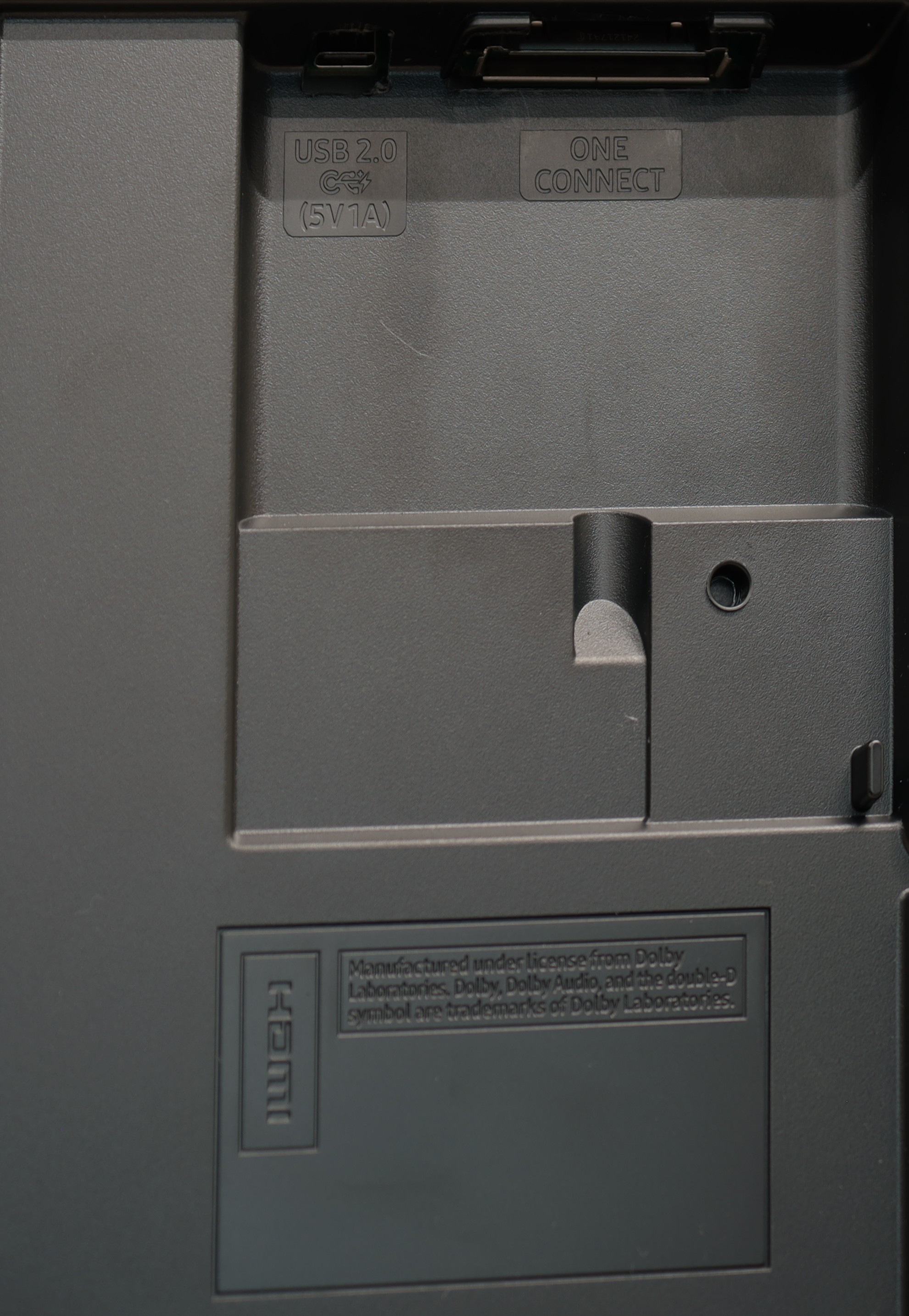
User features
Although the LG B5 is modern equipment, it hasn't forgotten about those who sometimes just want to... watch television. Without apps, without accounts, without logging in anywhere. It comes with built-in DVB-T2 tuners and the ability to record onto USB, along with a clear and fast EPG guide. Is that not enough? There’s even a working teletext – for many, probably a relic, for others, a daily necessity. We also appreciate the option to turn off the picture and leave just the sound, which is great for listening to music. And if you want to watch quietly – you can easily pair Bluetooth headphones, without a struggle with settings and without delays. Everything works as it should.
SMART TV: webOS
The biggest distinguishing feature of the webOS system – still! – is the way it is controlled. The Magic remote that comes with the LG B5 (in our version B56 – without a numeric keypad) works like a magic wand. You point, click, select. And it simply… works. Intuitively, quickly, and without unnecessary side-to-side clicking. Additionally, there’s an AI voice assistant – quite efficient. You can summon it directly from the remote and use your voice to search for content, change settings, or switch sources. WebOS may not be the most "modern" system on the market, and the built-in ads can be annoying, but when it comes to user convenience – especially with the Magic remote – it still outpaces the competition by a step.
Classic Television Features
In terms of classic features, The Frame does not stand out particularly from the competition. There are no options for recording to USB or PiP (picture-in-picture) functionality, which may be disappointing for some users. On the other hand, the television allows for simultaneous use of speakers and headphones, which can be useful – especially for older users. The EPG, or electronic programme guide, is quite readable, and despite the lack of conventional buttons on the remote, we were able to access teletext. In everyday use, the basic functions operate smoothly and without significant complaints.
Smart System – Tizen and Applications
The Frame 2025 runs on the Tizen system, which has long been regarded as one of the most refined Smart TV solutions on the market. This system is designed with the idea that devices are more than just a television – and it has been constructed with that spirit in mind. Tizen offers full integration with external devices – supporting both Apple AirPlay and Miracast. With the SmartThings app, it is possible to control not only the television but also other devices within the smart home framework. Since last year, Samsung has also been developing its own voice assistant with support for the Polish language, which significantly facilitates operation. However, the greatest strength of the Smart system in The Frame remains the Art Gallery application. Although access to it is paid (in the form of a subscription), it offers the best scans of works of art available on the market – referring to scans, not ordinary photographs. As a result, the effect of a digital painting hanging on the wall is markedly better than in any other lifestyle television.
Playing files from USB
8.6/10
8.5/10
Supported photo formats:
Maximum photo resolution:
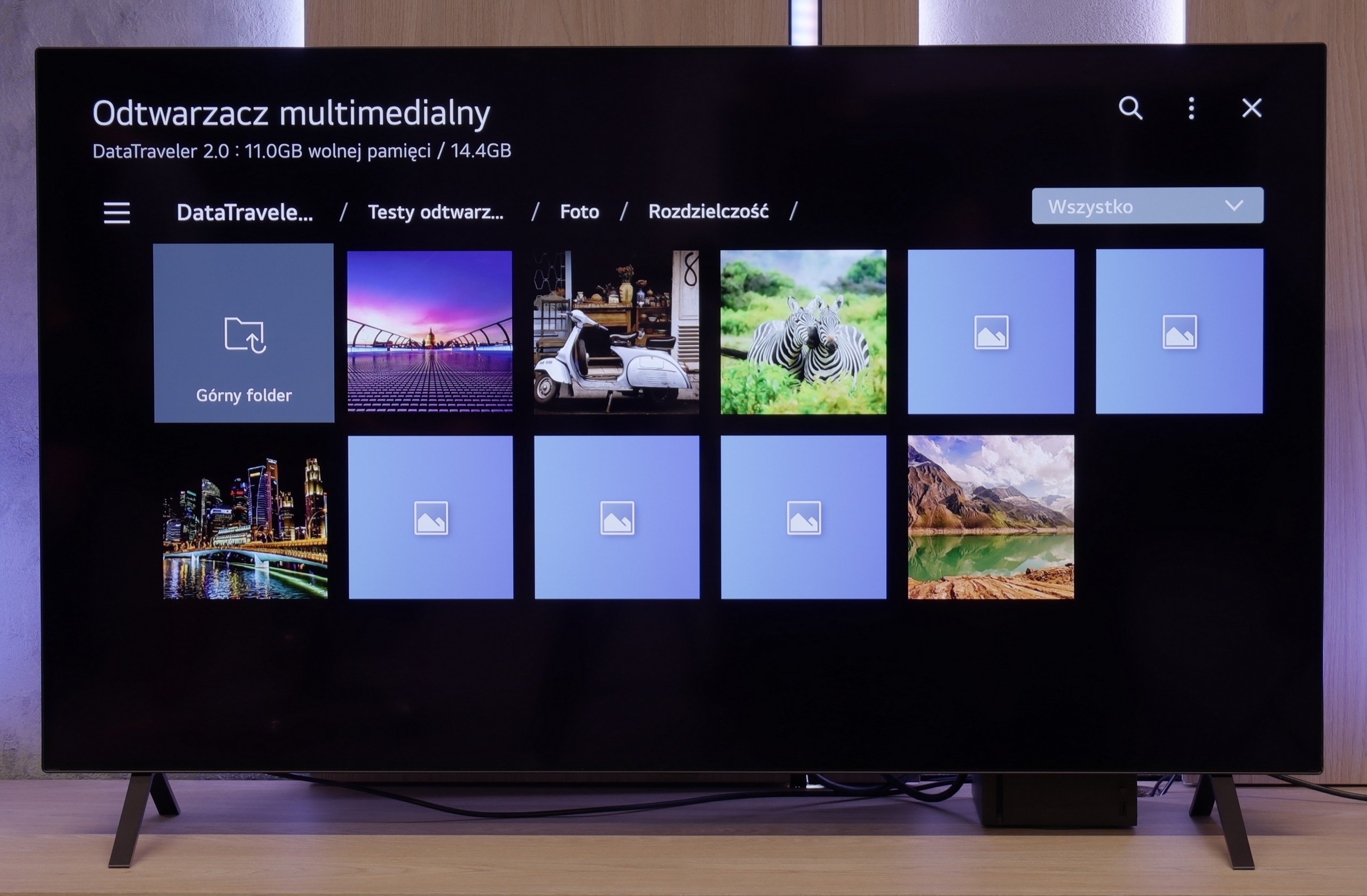

LG B5 handles files from USB as it should. Most popular formats work flawlessly, and subtitles – even with Polish characters – are displayed correctly. You can easily play a movie from a USB stick or have a weekend slideshow of your holiday photos without worrying that something will go wrong. However, there was a surprise with HEIC format files – that is, photos saved by Apple devices. While the LG C5 had no issues with them, the B5 stubbornly refused to cooperate and was unable to display them. A minor hiccup that probably won't affect everyone, but it's worth knowing about.
During testing, we did not notice any major issues with playing files from a USB memory stick. The television handled both video materials and photos well. Of course, there are some exceptions – for example, a lack of support for the HEIC format (used by Apple devices) – but it is difficult to consider this surprising. One positive aspect is the full support for high-resolution photos – the television displays files with a high number of megapixels without any problems, which may be particularly significant for those looking to treat The Frame as a digital frame as well. However, during testing, we noticed a limitation regarding subtitles – the television only correctly handled files in .txt format. It is worth keeping this in mind and ensuring that the downloaded subtitles for films are saved in this format; otherwise, they may simply not display.
Apps
8.7/10
8.7/10














































Sound
7/10
6/10
- Subjective sound quality:7/106/10
- Dolby Digital Plus 7.1:
- Dolby True HD 7.1:
- Dolby Atmos in Dolby Digital Plus (JOC):
- Dolby Atmos in Dolby True HD:
- DTS:X in DTS-HD MA:
- DTS-HD Master Audio:
We weren't expecting miracles – after all, the LG B5 doesn’t have an advanced audio system, and its built-in speakers look... well, like those in most flat-screen televisions. And yet – it sounded really pleasant. The dialogues are clear, the sound doesn’t boom, and during a calmer viewing, we didn’t immediately feel the need to connect a soundbar. It's a pity that this year LG decided to cut something that worked in the previous generation. We're of course talking about support for DTS formats, which we will no longer find in the B5. If you have films encoded in this format – you'll need to rely on an external player.
For such a slim television, the sound is quite good. It is full, sufficient for everyday viewing, but without much excitement – typical for flat constructions. There is little bass, although at times it can be heard. The speakers in a 2.0.2 arrangement have a total power of 40 W (in the 55+ inch version). Unfortunately, the television does not support the DTS format, so for films with that sound, one has to rely on external equipment, such as a home cinema. A soundbar can be connected, and thanks to the Q-Symphony feature, the television plays along with it. Samsung also offers visually matched models for The Frame like S700D or S800D, but they are sold separately. (This shouldn’t surprise anyone😉).


